Exploring Blockchain's Potential in Healthcare Data Management
VerifiedAdded on 2020/05/08
|23
|6205
|60
AI Summary
Blockchain technology offers transformative potential for healthcare by enhancing data privacy and security. By leveraging secure transaction logs and encrypted smart contracts, blockchain provides a robust framework for managing patient records while ensuring compliance with stringent regulations such as HIPAA. This analysis explores how decentralized and immutable ledgers can safeguard health information from unauthorized access, fraud, and breaches. Furthermore, the integration of blockchain in healthcare systems facilitates interoperability among different entities by providing a single source of truth, thereby improving efficiency and trust within the ecosystem. Through case studies and theoretical examination, this paper highlights both the opportunities and challenges associated with implementing blockchain solutions in the healthcare sector.
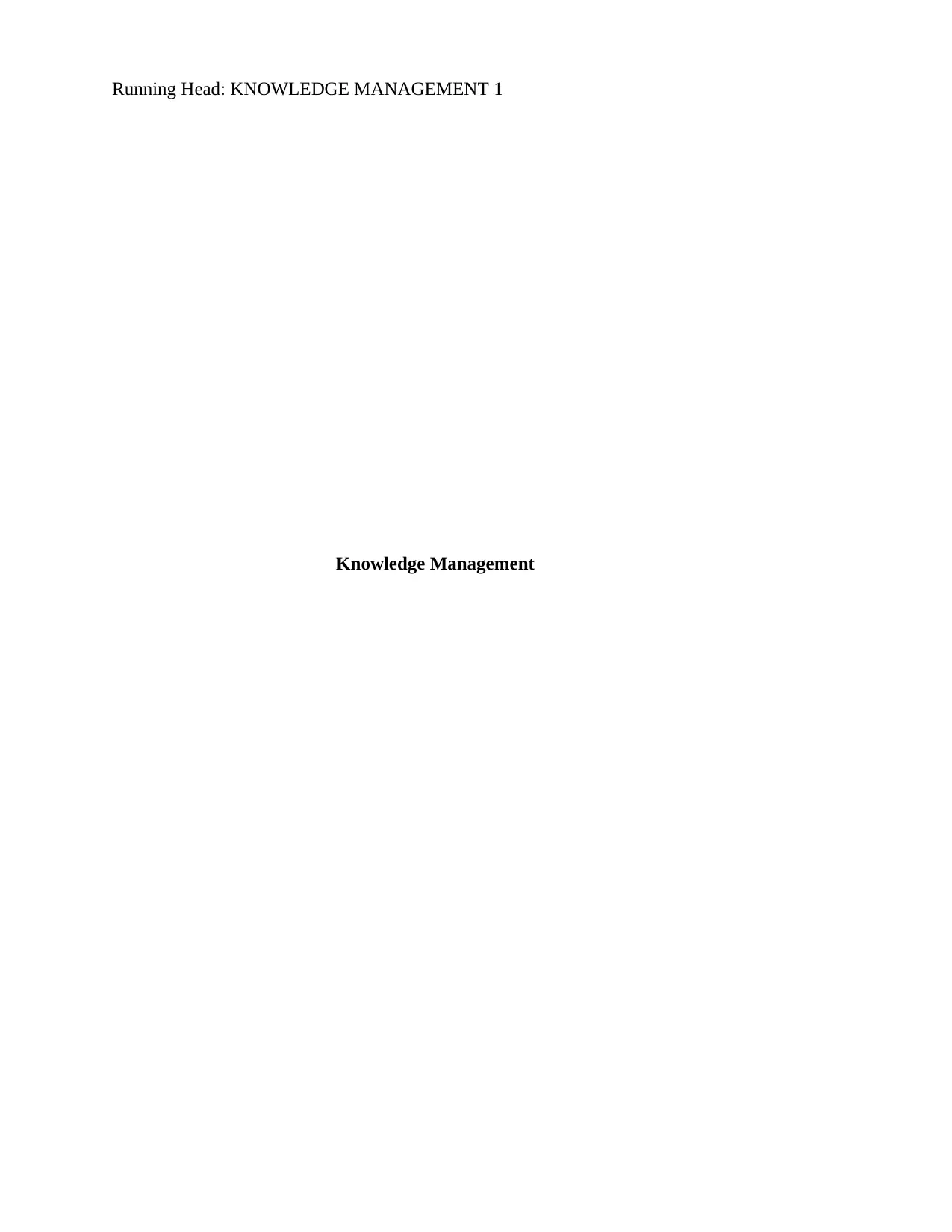
Running Head: KNOWLEDGE MANAGEMENT 1
Knowledge Management
Knowledge Management
Secure Best Marks with AI Grader
Need help grading? Try our AI Grader for instant feedback on your assignments.
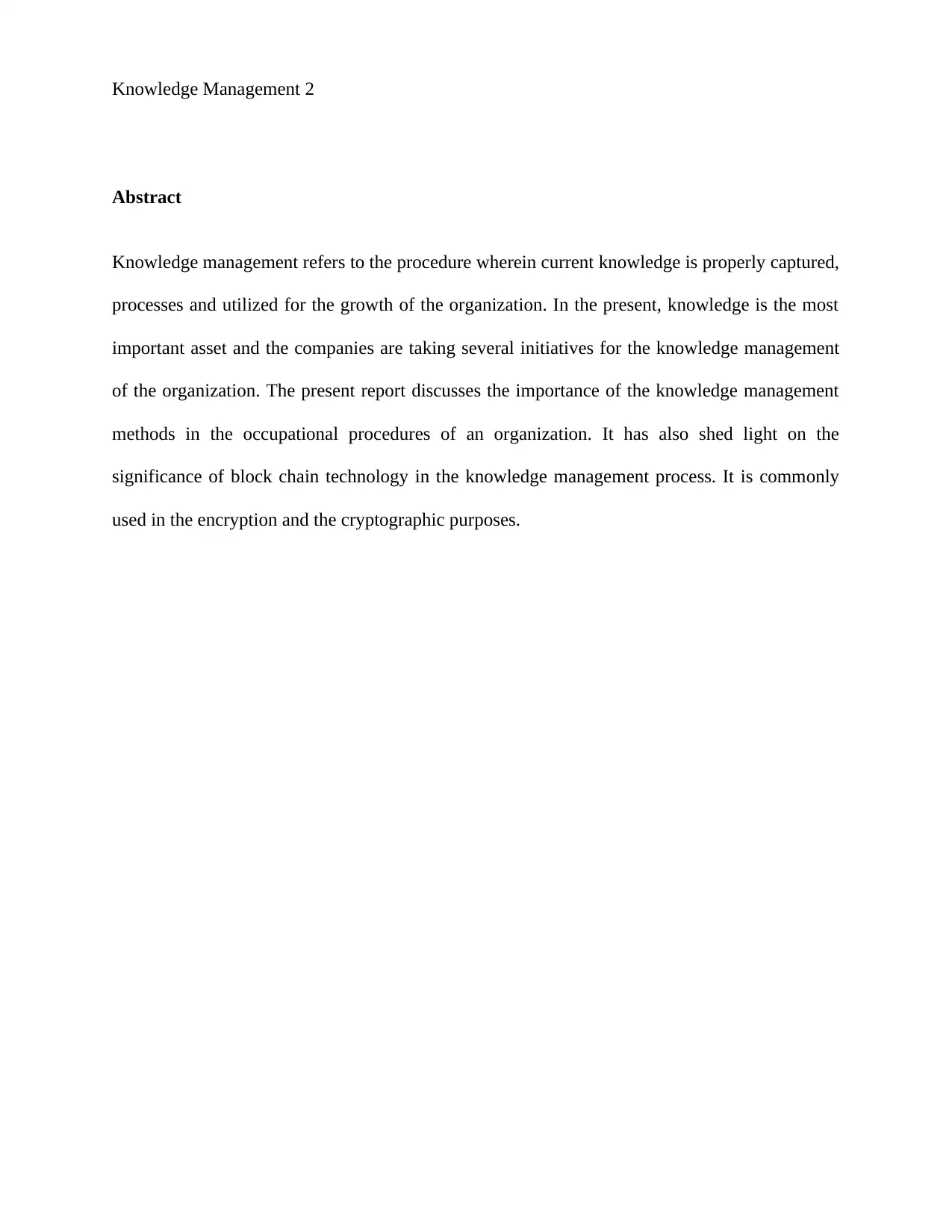
Knowledge Management 2
Abstract
Knowledge management refers to the procedure wherein current knowledge is properly captured,
processes and utilized for the growth of the organization. In the present, knowledge is the most
important asset and the companies are taking several initiatives for the knowledge management
of the organization. The present report discusses the importance of the knowledge management
methods in the occupational procedures of an organization. It has also shed light on the
significance of block chain technology in the knowledge management process. It is commonly
used in the encryption and the cryptographic purposes.
Abstract
Knowledge management refers to the procedure wherein current knowledge is properly captured,
processes and utilized for the growth of the organization. In the present, knowledge is the most
important asset and the companies are taking several initiatives for the knowledge management
of the organization. The present report discusses the importance of the knowledge management
methods in the occupational procedures of an organization. It has also shed light on the
significance of block chain technology in the knowledge management process. It is commonly
used in the encryption and the cryptographic purposes.
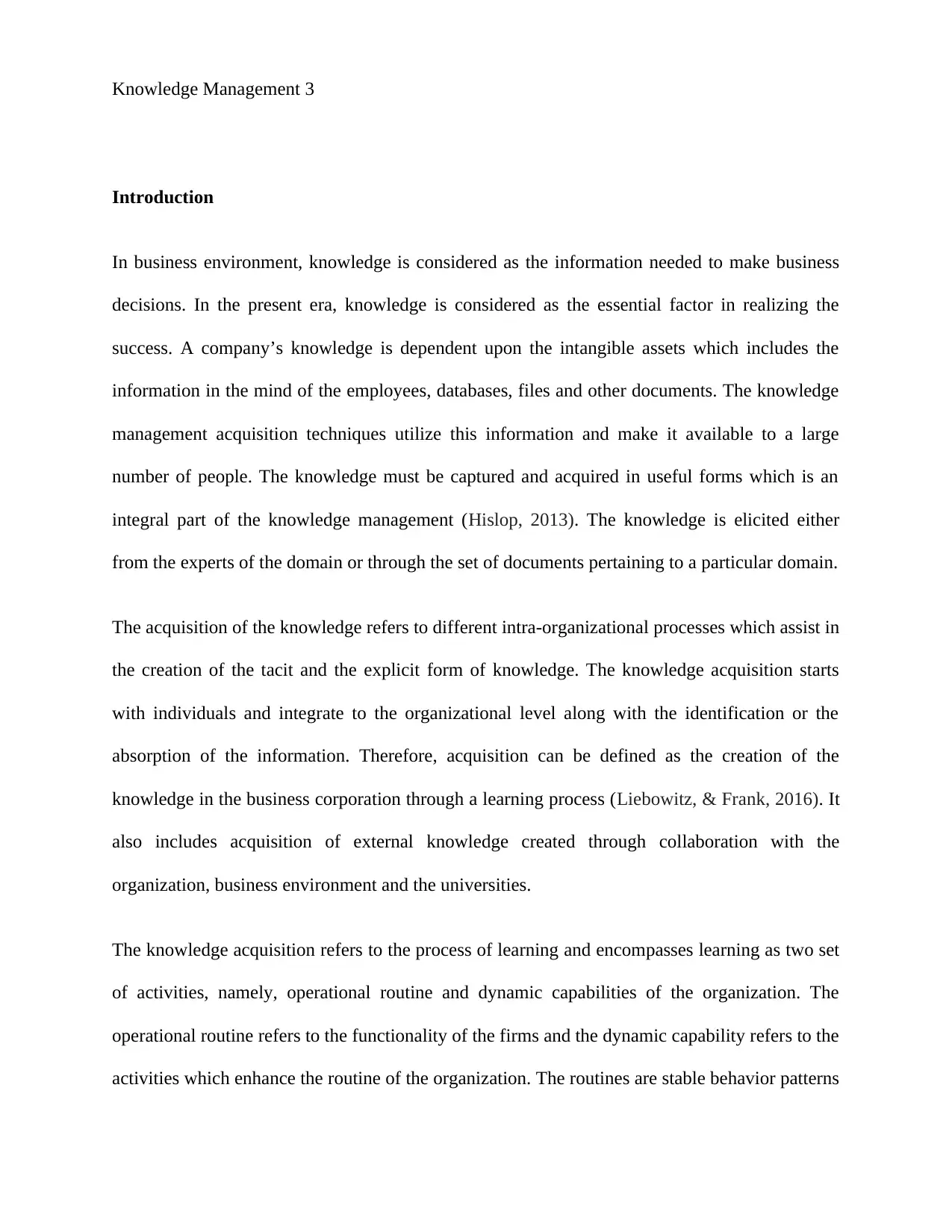
Knowledge Management 3
Introduction
In business environment, knowledge is considered as the information needed to make business
decisions. In the present era, knowledge is considered as the essential factor in realizing the
success. A company’s knowledge is dependent upon the intangible assets which includes the
information in the mind of the employees, databases, files and other documents. The knowledge
management acquisition techniques utilize this information and make it available to a large
number of people. The knowledge must be captured and acquired in useful forms which is an
integral part of the knowledge management (Hislop, 2013). The knowledge is elicited either
from the experts of the domain or through the set of documents pertaining to a particular domain.
The acquisition of the knowledge refers to different intra-organizational processes which assist in
the creation of the tacit and the explicit form of knowledge. The knowledge acquisition starts
with individuals and integrate to the organizational level along with the identification or the
absorption of the information. Therefore, acquisition can be defined as the creation of the
knowledge in the business corporation through a learning process (Liebowitz, & Frank, 2016). It
also includes acquisition of external knowledge created through collaboration with the
organization, business environment and the universities.
The knowledge acquisition refers to the process of learning and encompasses learning as two set
of activities, namely, operational routine and dynamic capabilities of the organization. The
operational routine refers to the functionality of the firms and the dynamic capability refers to the
activities which enhance the routine of the organization. The routines are stable behavior patterns
Introduction
In business environment, knowledge is considered as the information needed to make business
decisions. In the present era, knowledge is considered as the essential factor in realizing the
success. A company’s knowledge is dependent upon the intangible assets which includes the
information in the mind of the employees, databases, files and other documents. The knowledge
management acquisition techniques utilize this information and make it available to a large
number of people. The knowledge must be captured and acquired in useful forms which is an
integral part of the knowledge management (Hislop, 2013). The knowledge is elicited either
from the experts of the domain or through the set of documents pertaining to a particular domain.
The acquisition of the knowledge refers to different intra-organizational processes which assist in
the creation of the tacit and the explicit form of knowledge. The knowledge acquisition starts
with individuals and integrate to the organizational level along with the identification or the
absorption of the information. Therefore, acquisition can be defined as the creation of the
knowledge in the business corporation through a learning process (Liebowitz, & Frank, 2016). It
also includes acquisition of external knowledge created through collaboration with the
organization, business environment and the universities.
The knowledge acquisition refers to the process of learning and encompasses learning as two set
of activities, namely, operational routine and dynamic capabilities of the organization. The
operational routine refers to the functionality of the firms and the dynamic capability refers to the
activities which enhance the routine of the organization. The routines are stable behavior patterns
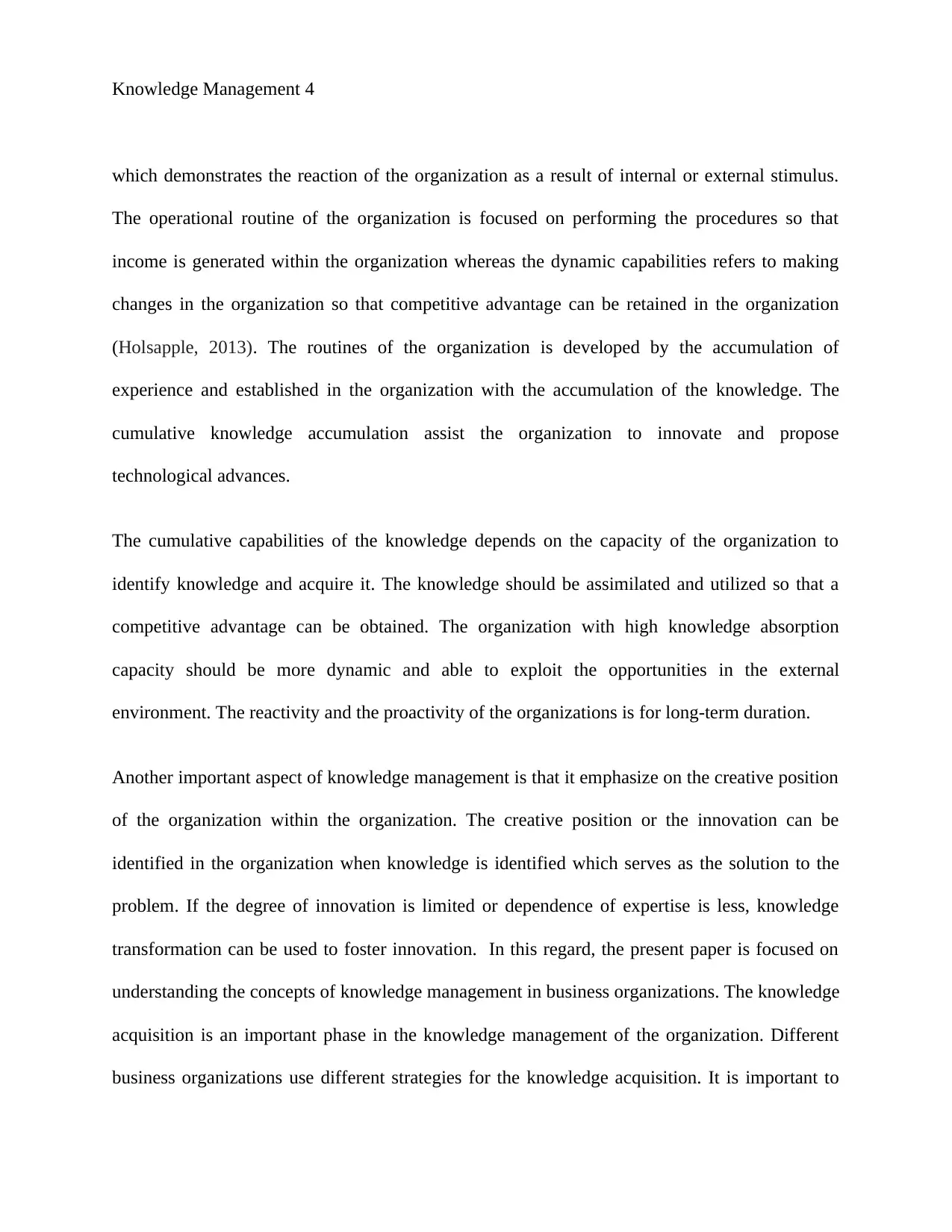
Knowledge Management 4
which demonstrates the reaction of the organization as a result of internal or external stimulus.
The operational routine of the organization is focused on performing the procedures so that
income is generated within the organization whereas the dynamic capabilities refers to making
changes in the organization so that competitive advantage can be retained in the organization
(Holsapple, 2013). The routines of the organization is developed by the accumulation of
experience and established in the organization with the accumulation of the knowledge. The
cumulative knowledge accumulation assist the organization to innovate and propose
technological advances.
The cumulative capabilities of the knowledge depends on the capacity of the organization to
identify knowledge and acquire it. The knowledge should be assimilated and utilized so that a
competitive advantage can be obtained. The organization with high knowledge absorption
capacity should be more dynamic and able to exploit the opportunities in the external
environment. The reactivity and the proactivity of the organizations is for long-term duration.
Another important aspect of knowledge management is that it emphasize on the creative position
of the organization within the organization. The creative position or the innovation can be
identified in the organization when knowledge is identified which serves as the solution to the
problem. If the degree of innovation is limited or dependence of expertise is less, knowledge
transformation can be used to foster innovation. In this regard, the present paper is focused on
understanding the concepts of knowledge management in business organizations. The knowledge
acquisition is an important phase in the knowledge management of the organization. Different
business organizations use different strategies for the knowledge acquisition. It is important to
which demonstrates the reaction of the organization as a result of internal or external stimulus.
The operational routine of the organization is focused on performing the procedures so that
income is generated within the organization whereas the dynamic capabilities refers to making
changes in the organization so that competitive advantage can be retained in the organization
(Holsapple, 2013). The routines of the organization is developed by the accumulation of
experience and established in the organization with the accumulation of the knowledge. The
cumulative knowledge accumulation assist the organization to innovate and propose
technological advances.
The cumulative capabilities of the knowledge depends on the capacity of the organization to
identify knowledge and acquire it. The knowledge should be assimilated and utilized so that a
competitive advantage can be obtained. The organization with high knowledge absorption
capacity should be more dynamic and able to exploit the opportunities in the external
environment. The reactivity and the proactivity of the organizations is for long-term duration.
Another important aspect of knowledge management is that it emphasize on the creative position
of the organization within the organization. The creative position or the innovation can be
identified in the organization when knowledge is identified which serves as the solution to the
problem. If the degree of innovation is limited or dependence of expertise is less, knowledge
transformation can be used to foster innovation. In this regard, the present paper is focused on
understanding the concepts of knowledge management in business organizations. The knowledge
acquisition is an important phase in the knowledge management of the organization. Different
business organizations use different strategies for the knowledge acquisition. It is important to
Secure Best Marks with AI Grader
Need help grading? Try our AI Grader for instant feedback on your assignments.
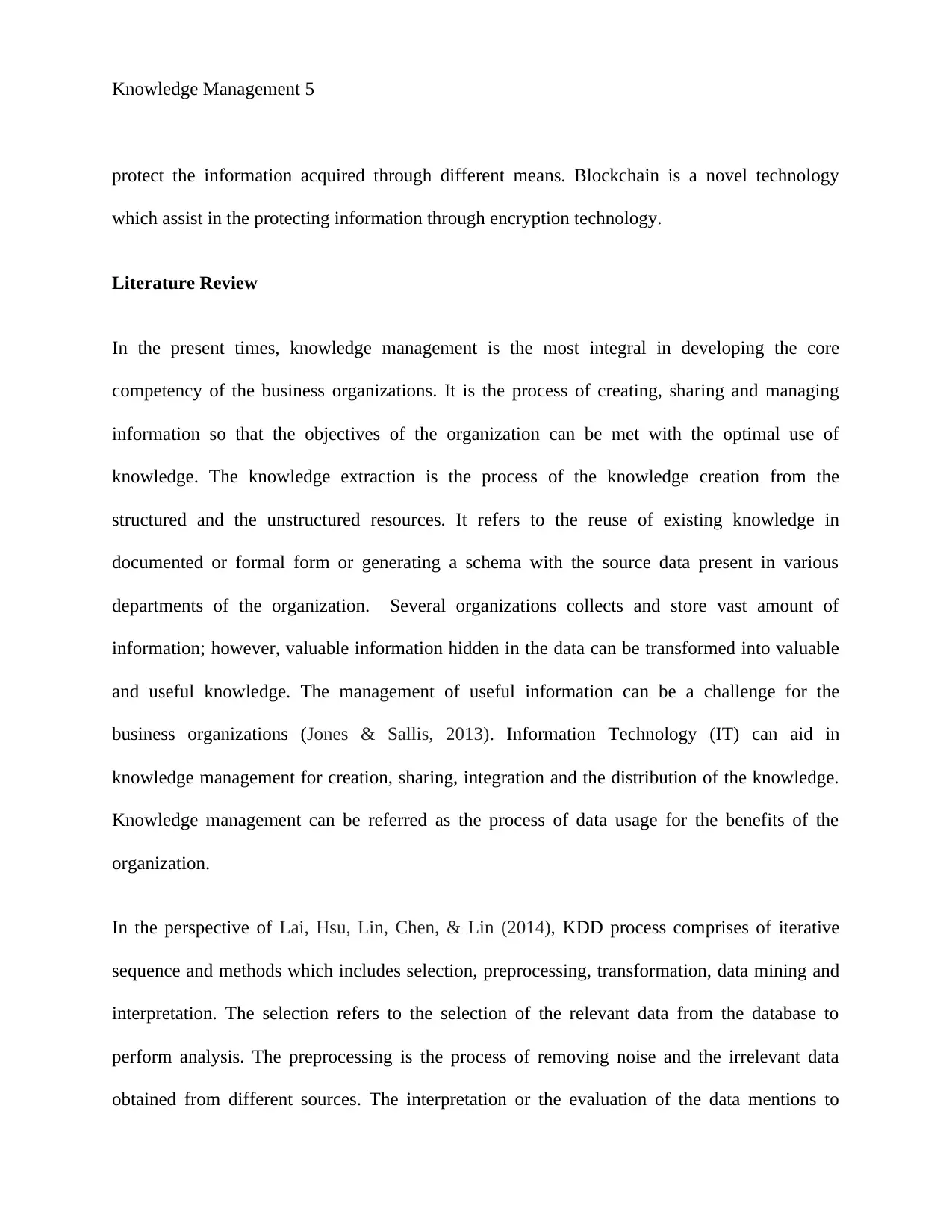
Knowledge Management 5
protect the information acquired through different means. Blockchain is a novel technology
which assist in the protecting information through encryption technology.
Literature Review
In the present times, knowledge management is the most integral in developing the core
competency of the business organizations. It is the process of creating, sharing and managing
information so that the objectives of the organization can be met with the optimal use of
knowledge. The knowledge extraction is the process of the knowledge creation from the
structured and the unstructured resources. It refers to the reuse of existing knowledge in
documented or formal form or generating a schema with the source data present in various
departments of the organization. Several organizations collects and store vast amount of
information; however, valuable information hidden in the data can be transformed into valuable
and useful knowledge. The management of useful information can be a challenge for the
business organizations (Jones & Sallis, 2013). Information Technology (IT) can aid in
knowledge management for creation, sharing, integration and the distribution of the knowledge.
Knowledge management can be referred as the process of data usage for the benefits of the
organization.
In the perspective of Lai, Hsu, Lin, Chen, & Lin (2014), KDD process comprises of iterative
sequence and methods which includes selection, preprocessing, transformation, data mining and
interpretation. The selection refers to the selection of the relevant data from the database to
perform analysis. The preprocessing is the process of removing noise and the irrelevant data
obtained from different sources. The interpretation or the evaluation of the data mentions to
protect the information acquired through different means. Blockchain is a novel technology
which assist in the protecting information through encryption technology.
Literature Review
In the present times, knowledge management is the most integral in developing the core
competency of the business organizations. It is the process of creating, sharing and managing
information so that the objectives of the organization can be met with the optimal use of
knowledge. The knowledge extraction is the process of the knowledge creation from the
structured and the unstructured resources. It refers to the reuse of existing knowledge in
documented or formal form or generating a schema with the source data present in various
departments of the organization. Several organizations collects and store vast amount of
information; however, valuable information hidden in the data can be transformed into valuable
and useful knowledge. The management of useful information can be a challenge for the
business organizations (Jones & Sallis, 2013). Information Technology (IT) can aid in
knowledge management for creation, sharing, integration and the distribution of the knowledge.
Knowledge management can be referred as the process of data usage for the benefits of the
organization.
In the perspective of Lai, Hsu, Lin, Chen, & Lin (2014), KDD process comprises of iterative
sequence and methods which includes selection, preprocessing, transformation, data mining and
interpretation. The selection refers to the selection of the relevant data from the database to
perform analysis. The preprocessing is the process of removing noise and the irrelevant data
obtained from different sources. The interpretation or the evaluation of the data mentions to
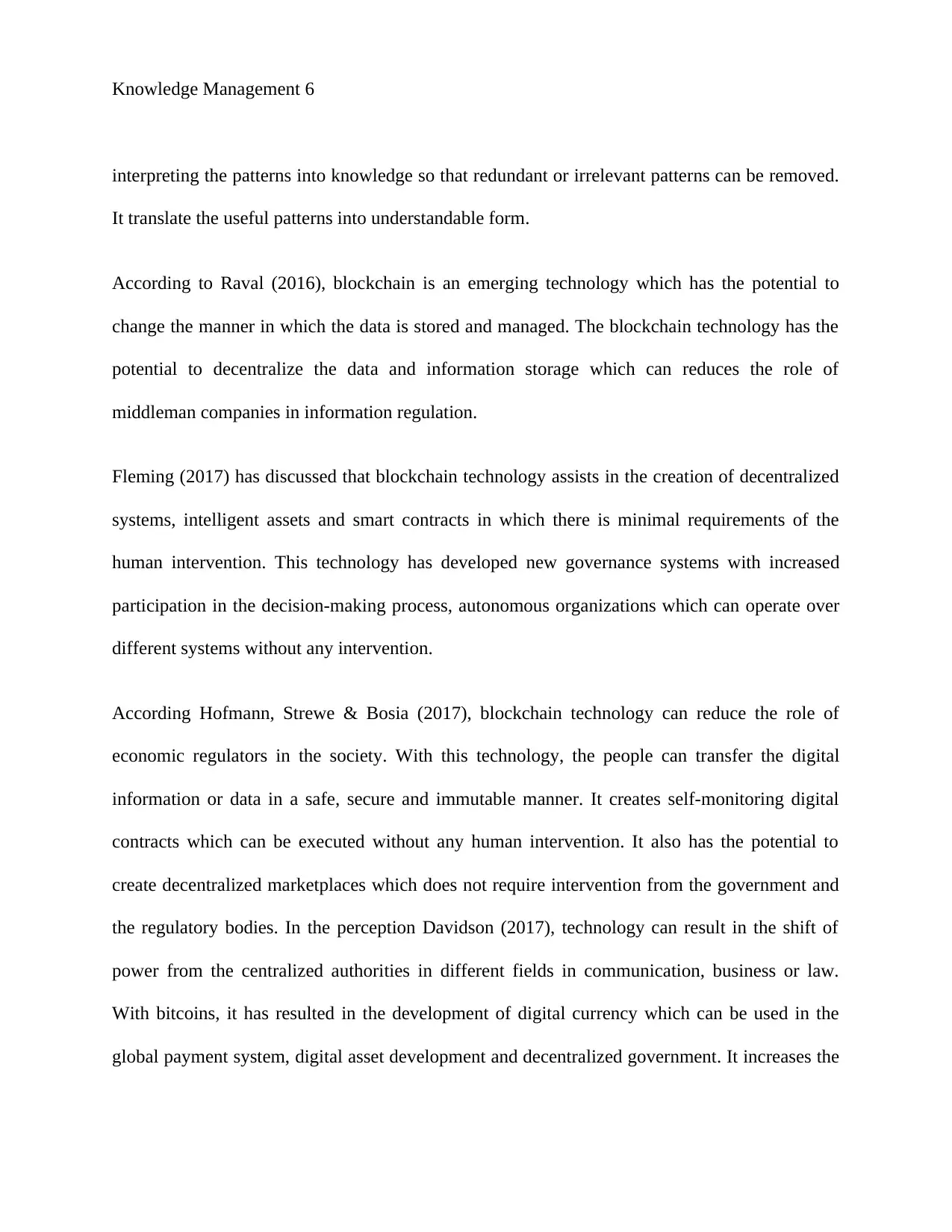
Knowledge Management 6
interpreting the patterns into knowledge so that redundant or irrelevant patterns can be removed.
It translate the useful patterns into understandable form.
According to Raval (2016), blockchain is an emerging technology which has the potential to
change the manner in which the data is stored and managed. The blockchain technology has the
potential to decentralize the data and information storage which can reduces the role of
middleman companies in information regulation.
Fleming (2017) has discussed that blockchain technology assists in the creation of decentralized
systems, intelligent assets and smart contracts in which there is minimal requirements of the
human intervention. This technology has developed new governance systems with increased
participation in the decision-making process, autonomous organizations which can operate over
different systems without any intervention.
According Hofmann, Strewe & Bosia (2017), blockchain technology can reduce the role of
economic regulators in the society. With this technology, the people can transfer the digital
information or data in a safe, secure and immutable manner. It creates self-monitoring digital
contracts which can be executed without any human intervention. It also has the potential to
create decentralized marketplaces which does not require intervention from the government and
the regulatory bodies. In the perception Davidson (2017), technology can result in the shift of
power from the centralized authorities in different fields in communication, business or law.
With bitcoins, it has resulted in the development of digital currency which can be used in the
global payment system, digital asset development and decentralized government. It increases the
interpreting the patterns into knowledge so that redundant or irrelevant patterns can be removed.
It translate the useful patterns into understandable form.
According to Raval (2016), blockchain is an emerging technology which has the potential to
change the manner in which the data is stored and managed. The blockchain technology has the
potential to decentralize the data and information storage which can reduces the role of
middleman companies in information regulation.
Fleming (2017) has discussed that blockchain technology assists in the creation of decentralized
systems, intelligent assets and smart contracts in which there is minimal requirements of the
human intervention. This technology has developed new governance systems with increased
participation in the decision-making process, autonomous organizations which can operate over
different systems without any intervention.
According Hofmann, Strewe & Bosia (2017), blockchain technology can reduce the role of
economic regulators in the society. With this technology, the people can transfer the digital
information or data in a safe, secure and immutable manner. It creates self-monitoring digital
contracts which can be executed without any human intervention. It also has the potential to
create decentralized marketplaces which does not require intervention from the government and
the regulatory bodies. In the perception Davidson (2017), technology can result in the shift of
power from the centralized authorities in different fields in communication, business or law.
With bitcoins, it has resulted in the development of digital currency which can be used in the
global payment system, digital asset development and decentralized government. It increases the
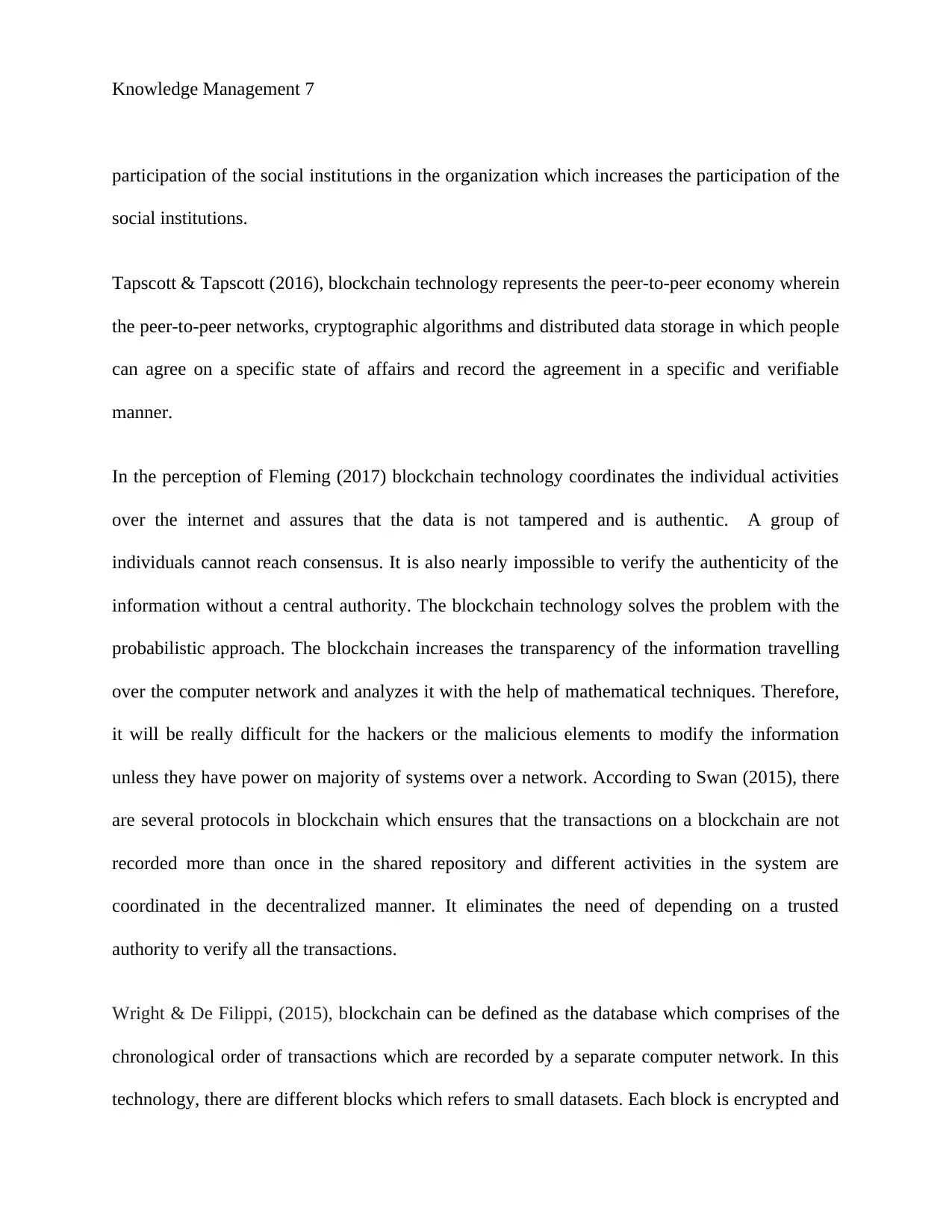
Knowledge Management 7
participation of the social institutions in the organization which increases the participation of the
social institutions.
Tapscott & Tapscott (2016), blockchain technology represents the peer-to-peer economy wherein
the peer-to-peer networks, cryptographic algorithms and distributed data storage in which people
can agree on a specific state of affairs and record the agreement in a specific and verifiable
manner.
In the perception of Fleming (2017) blockchain technology coordinates the individual activities
over the internet and assures that the data is not tampered and is authentic. A group of
individuals cannot reach consensus. It is also nearly impossible to verify the authenticity of the
information without a central authority. The blockchain technology solves the problem with the
probabilistic approach. The blockchain increases the transparency of the information travelling
over the computer network and analyzes it with the help of mathematical techniques. Therefore,
it will be really difficult for the hackers or the malicious elements to modify the information
unless they have power on majority of systems over a network. According to Swan (2015), there
are several protocols in blockchain which ensures that the transactions on a blockchain are not
recorded more than once in the shared repository and different activities in the system are
coordinated in the decentralized manner. It eliminates the need of depending on a trusted
authority to verify all the transactions.
Wright & De Filippi, (2015), blockchain can be defined as the database which comprises of the
chronological order of transactions which are recorded by a separate computer network. In this
technology, there are different blocks which refers to small datasets. Each block is encrypted and
participation of the social institutions in the organization which increases the participation of the
social institutions.
Tapscott & Tapscott (2016), blockchain technology represents the peer-to-peer economy wherein
the peer-to-peer networks, cryptographic algorithms and distributed data storage in which people
can agree on a specific state of affairs and record the agreement in a specific and verifiable
manner.
In the perception of Fleming (2017) blockchain technology coordinates the individual activities
over the internet and assures that the data is not tampered and is authentic. A group of
individuals cannot reach consensus. It is also nearly impossible to verify the authenticity of the
information without a central authority. The blockchain technology solves the problem with the
probabilistic approach. The blockchain increases the transparency of the information travelling
over the computer network and analyzes it with the help of mathematical techniques. Therefore,
it will be really difficult for the hackers or the malicious elements to modify the information
unless they have power on majority of systems over a network. According to Swan (2015), there
are several protocols in blockchain which ensures that the transactions on a blockchain are not
recorded more than once in the shared repository and different activities in the system are
coordinated in the decentralized manner. It eliminates the need of depending on a trusted
authority to verify all the transactions.
Wright & De Filippi, (2015), blockchain can be defined as the database which comprises of the
chronological order of transactions which are recorded by a separate computer network. In this
technology, there are different blocks which refers to small datasets. Each block is encrypted and
Paraphrase This Document
Need a fresh take? Get an instant paraphrase of this document with our AI Paraphraser
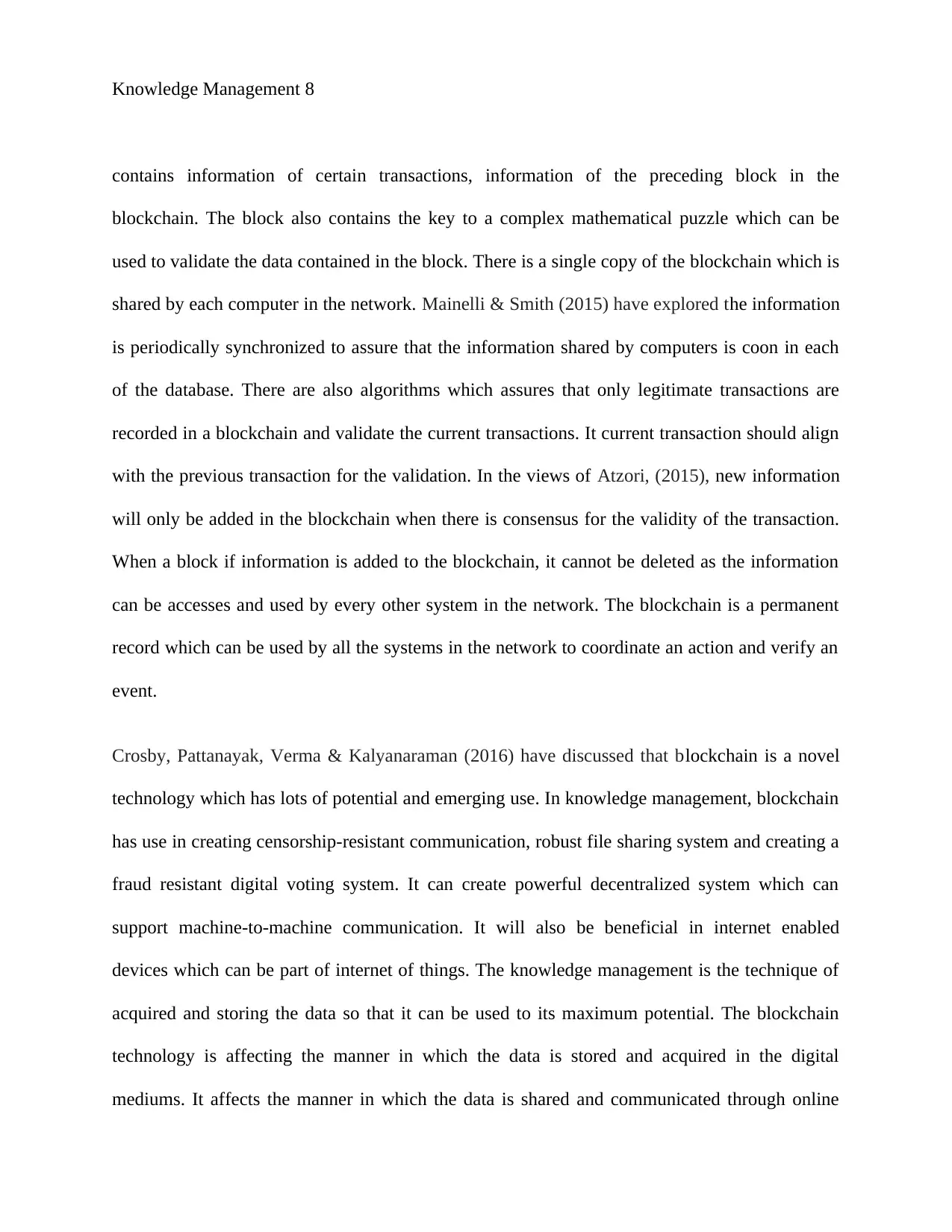
Knowledge Management 8
contains information of certain transactions, information of the preceding block in the
blockchain. The block also contains the key to a complex mathematical puzzle which can be
used to validate the data contained in the block. There is a single copy of the blockchain which is
shared by each computer in the network. Mainelli & Smith (2015) have explored the information
is periodically synchronized to assure that the information shared by computers is coon in each
of the database. There are also algorithms which assures that only legitimate transactions are
recorded in a blockchain and validate the current transactions. It current transaction should align
with the previous transaction for the validation. In the views of Atzori, (2015), new information
will only be added in the blockchain when there is consensus for the validity of the transaction.
When a block if information is added to the blockchain, it cannot be deleted as the information
can be accesses and used by every other system in the network. The blockchain is a permanent
record which can be used by all the systems in the network to coordinate an action and verify an
event.
Crosby, Pattanayak, Verma & Kalyanaraman (2016) have discussed that blockchain is a novel
technology which has lots of potential and emerging use. In knowledge management, blockchain
has use in creating censorship-resistant communication, robust file sharing system and creating a
fraud resistant digital voting system. It can create powerful decentralized system which can
support machine-to-machine communication. It will also be beneficial in internet enabled
devices which can be part of internet of things. The knowledge management is the technique of
acquired and storing the data so that it can be used to its maximum potential. The blockchain
technology is affecting the manner in which the data is stored and acquired in the digital
mediums. It affects the manner in which the data is shared and communicated through online
contains information of certain transactions, information of the preceding block in the
blockchain. The block also contains the key to a complex mathematical puzzle which can be
used to validate the data contained in the block. There is a single copy of the blockchain which is
shared by each computer in the network. Mainelli & Smith (2015) have explored the information
is periodically synchronized to assure that the information shared by computers is coon in each
of the database. There are also algorithms which assures that only legitimate transactions are
recorded in a blockchain and validate the current transactions. It current transaction should align
with the previous transaction for the validation. In the views of Atzori, (2015), new information
will only be added in the blockchain when there is consensus for the validity of the transaction.
When a block if information is added to the blockchain, it cannot be deleted as the information
can be accesses and used by every other system in the network. The blockchain is a permanent
record which can be used by all the systems in the network to coordinate an action and verify an
event.
Crosby, Pattanayak, Verma & Kalyanaraman (2016) have discussed that blockchain is a novel
technology which has lots of potential and emerging use. In knowledge management, blockchain
has use in creating censorship-resistant communication, robust file sharing system and creating a
fraud resistant digital voting system. It can create powerful decentralized system which can
support machine-to-machine communication. It will also be beneficial in internet enabled
devices which can be part of internet of things. The knowledge management is the technique of
acquired and storing the data so that it can be used to its maximum potential. The blockchain
technology is affecting the manner in which the data is stored and acquired in the digital
mediums. It affects the manner in which the data is shared and communicated through online
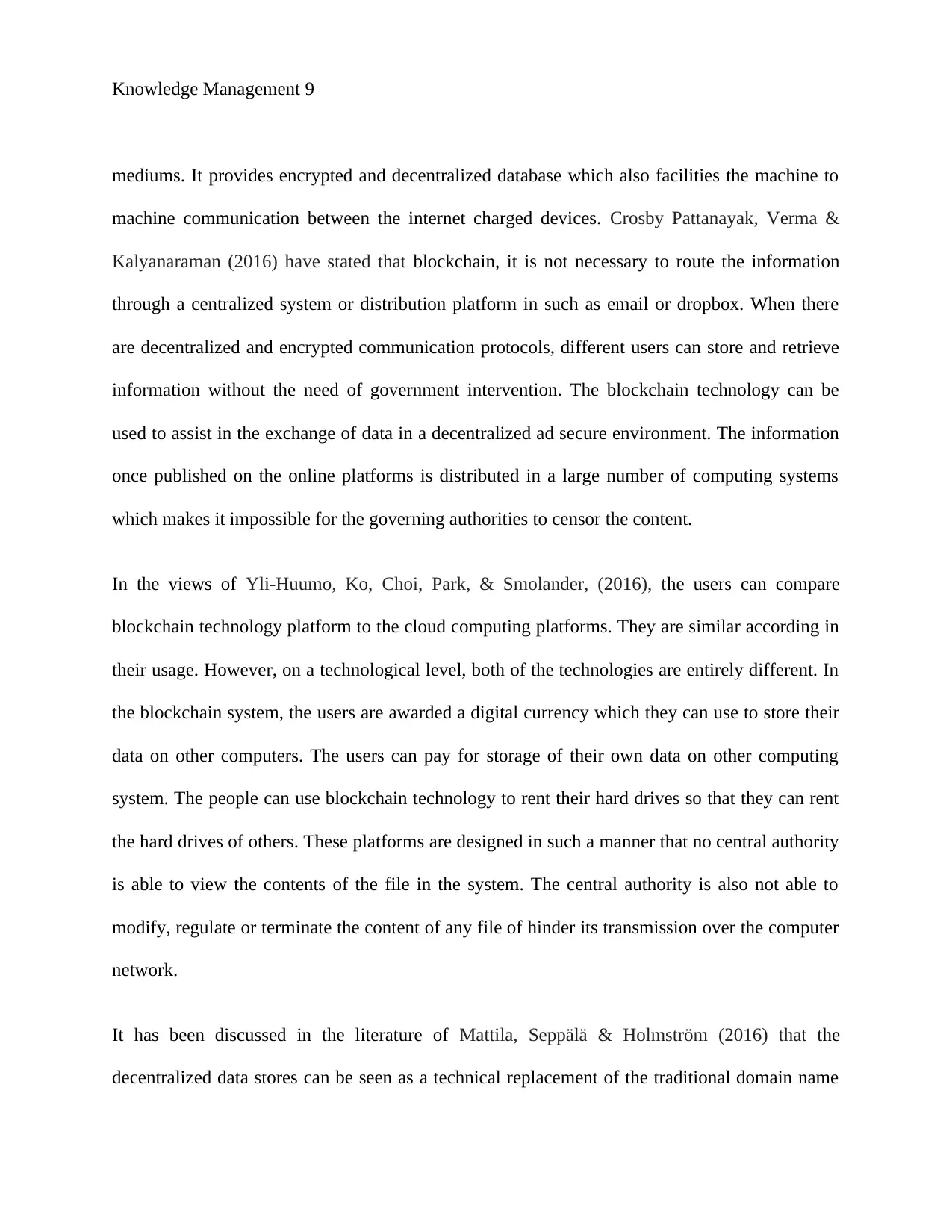
Knowledge Management 9
mediums. It provides encrypted and decentralized database which also facilities the machine to
machine communication between the internet charged devices. Crosby Pattanayak, Verma &
Kalyanaraman (2016) have stated that blockchain, it is not necessary to route the information
through a centralized system or distribution platform in such as email or dropbox. When there
are decentralized and encrypted communication protocols, different users can store and retrieve
information without the need of government intervention. The blockchain technology can be
used to assist in the exchange of data in a decentralized ad secure environment. The information
once published on the online platforms is distributed in a large number of computing systems
which makes it impossible for the governing authorities to censor the content.
In the views of Yli-Huumo, Ko, Choi, Park, & Smolander, (2016), the users can compare
blockchain technology platform to the cloud computing platforms. They are similar according in
their usage. However, on a technological level, both of the technologies are entirely different. In
the blockchain system, the users are awarded a digital currency which they can use to store their
data on other computers. The users can pay for storage of their own data on other computing
system. The people can use blockchain technology to rent their hard drives so that they can rent
the hard drives of others. These platforms are designed in such a manner that no central authority
is able to view the contents of the file in the system. The central authority is also not able to
modify, regulate or terminate the content of any file of hinder its transmission over the computer
network.
It has been discussed in the literature of Mattila, Seppälä & Holmström (2016) that the
decentralized data stores can be seen as a technical replacement of the traditional domain name
mediums. It provides encrypted and decentralized database which also facilities the machine to
machine communication between the internet charged devices. Crosby Pattanayak, Verma &
Kalyanaraman (2016) have stated that blockchain, it is not necessary to route the information
through a centralized system or distribution platform in such as email or dropbox. When there
are decentralized and encrypted communication protocols, different users can store and retrieve
information without the need of government intervention. The blockchain technology can be
used to assist in the exchange of data in a decentralized ad secure environment. The information
once published on the online platforms is distributed in a large number of computing systems
which makes it impossible for the governing authorities to censor the content.
In the views of Yli-Huumo, Ko, Choi, Park, & Smolander, (2016), the users can compare
blockchain technology platform to the cloud computing platforms. They are similar according in
their usage. However, on a technological level, both of the technologies are entirely different. In
the blockchain system, the users are awarded a digital currency which they can use to store their
data on other computers. The users can pay for storage of their own data on other computing
system. The people can use blockchain technology to rent their hard drives so that they can rent
the hard drives of others. These platforms are designed in such a manner that no central authority
is able to view the contents of the file in the system. The central authority is also not able to
modify, regulate or terminate the content of any file of hinder its transmission over the computer
network.
It has been discussed in the literature of Mattila, Seppälä & Holmström (2016) that the
decentralized data stores can be seen as a technical replacement of the traditional domain name
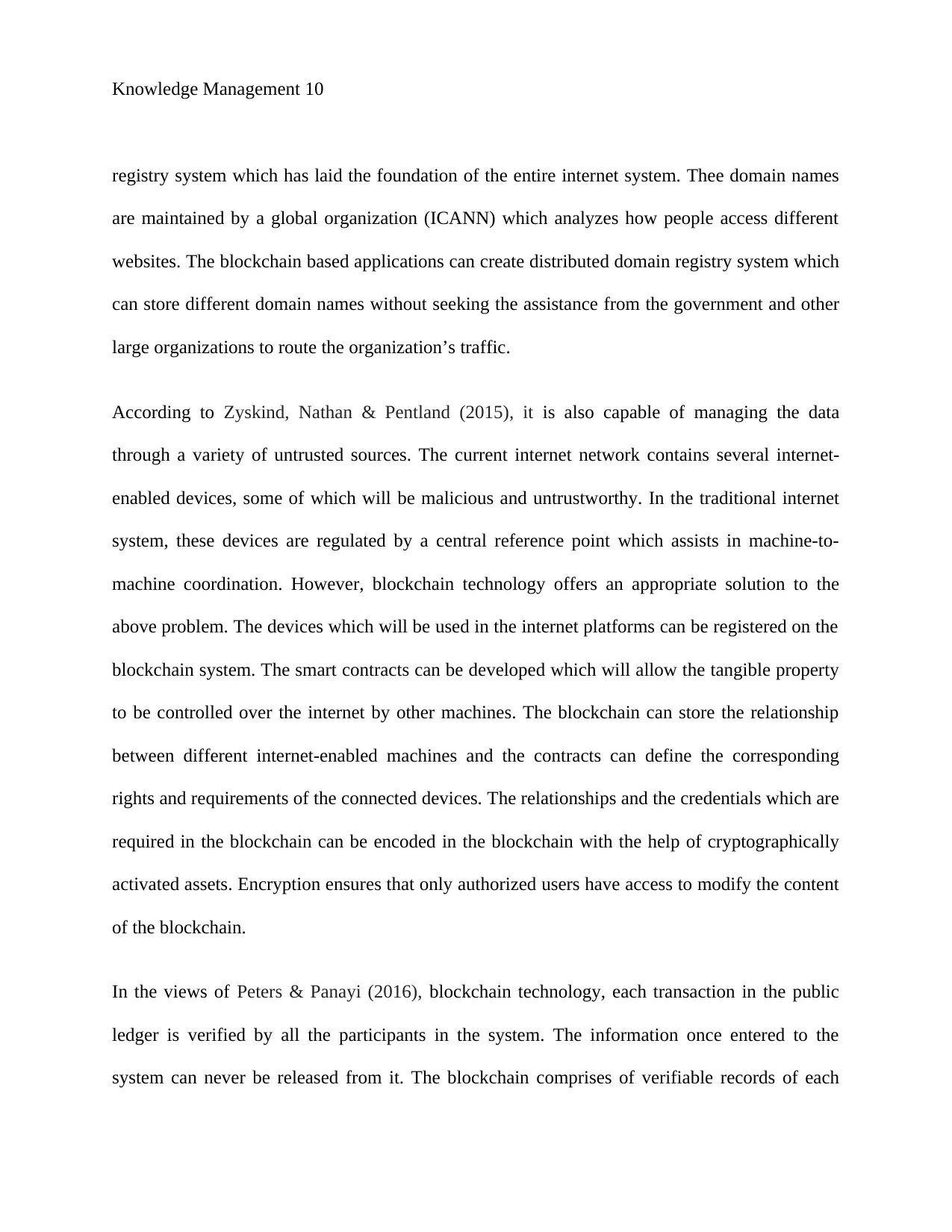
Knowledge Management 10
registry system which has laid the foundation of the entire internet system. Thee domain names
are maintained by a global organization (ICANN) which analyzes how people access different
websites. The blockchain based applications can create distributed domain registry system which
can store different domain names without seeking the assistance from the government and other
large organizations to route the organization’s traffic.
According to Zyskind, Nathan & Pentland (2015), it is also capable of managing the data
through a variety of untrusted sources. The current internet network contains several internet-
enabled devices, some of which will be malicious and untrustworthy. In the traditional internet
system, these devices are regulated by a central reference point which assists in machine-to-
machine coordination. However, blockchain technology offers an appropriate solution to the
above problem. The devices which will be used in the internet platforms can be registered on the
blockchain system. The smart contracts can be developed which will allow the tangible property
to be controlled over the internet by other machines. The blockchain can store the relationship
between different internet-enabled machines and the contracts can define the corresponding
rights and requirements of the connected devices. The relationships and the credentials which are
required in the blockchain can be encoded in the blockchain with the help of cryptographically
activated assets. Encryption ensures that only authorized users have access to modify the content
of the blockchain.
In the views of Peters & Panayi (2016), blockchain technology, each transaction in the public
ledger is verified by all the participants in the system. The information once entered to the
system can never be released from it. The blockchain comprises of verifiable records of each
registry system which has laid the foundation of the entire internet system. Thee domain names
are maintained by a global organization (ICANN) which analyzes how people access different
websites. The blockchain based applications can create distributed domain registry system which
can store different domain names without seeking the assistance from the government and other
large organizations to route the organization’s traffic.
According to Zyskind, Nathan & Pentland (2015), it is also capable of managing the data
through a variety of untrusted sources. The current internet network contains several internet-
enabled devices, some of which will be malicious and untrustworthy. In the traditional internet
system, these devices are regulated by a central reference point which assists in machine-to-
machine coordination. However, blockchain technology offers an appropriate solution to the
above problem. The devices which will be used in the internet platforms can be registered on the
blockchain system. The smart contracts can be developed which will allow the tangible property
to be controlled over the internet by other machines. The blockchain can store the relationship
between different internet-enabled machines and the contracts can define the corresponding
rights and requirements of the connected devices. The relationships and the credentials which are
required in the blockchain can be encoded in the blockchain with the help of cryptographically
activated assets. Encryption ensures that only authorized users have access to modify the content
of the blockchain.
In the views of Peters & Panayi (2016), blockchain technology, each transaction in the public
ledger is verified by all the participants in the system. The information once entered to the
system can never be released from it. The blockchain comprises of verifiable records of each
Secure Best Marks with AI Grader
Need help grading? Try our AI Grader for instant feedback on your assignments.
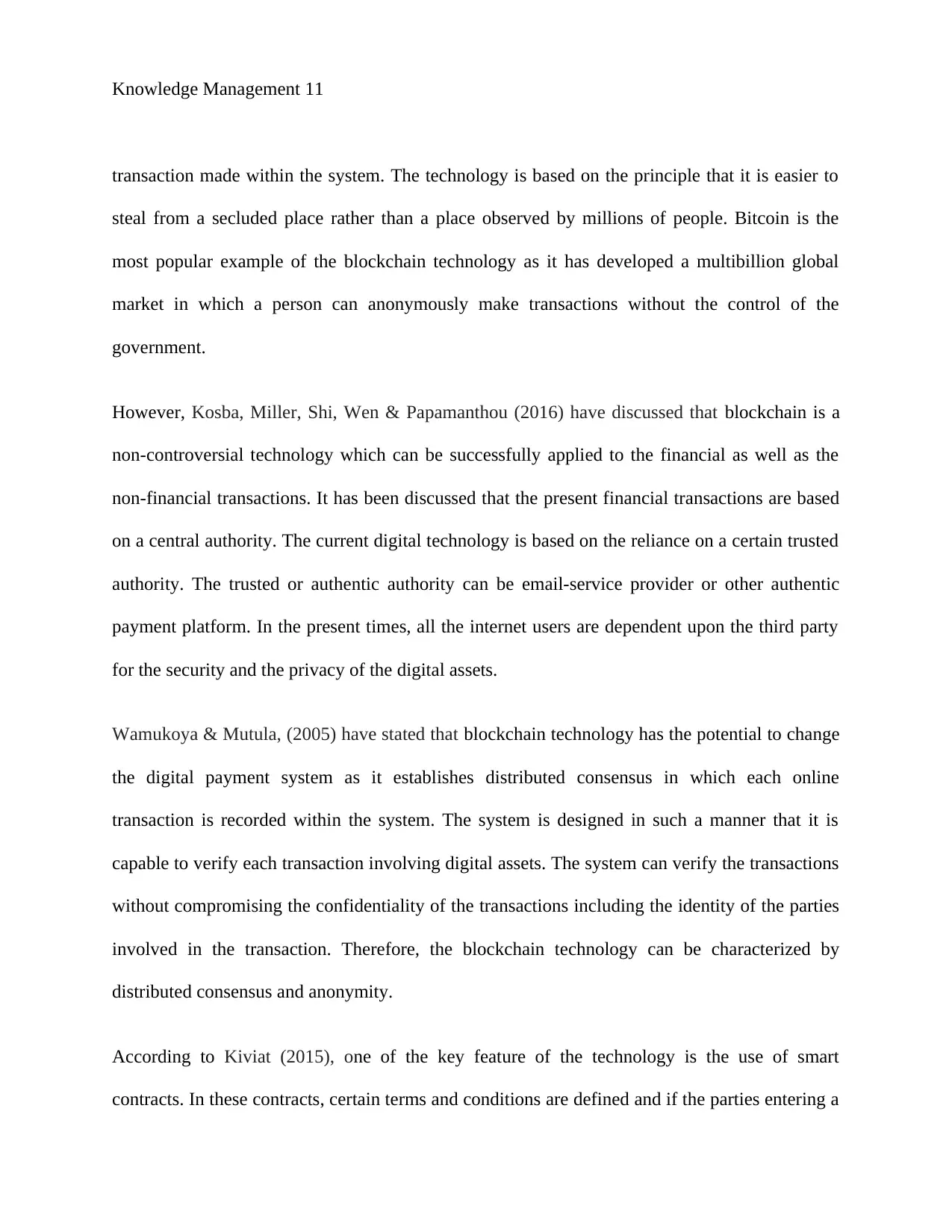
Knowledge Management 11
transaction made within the system. The technology is based on the principle that it is easier to
steal from a secluded place rather than a place observed by millions of people. Bitcoin is the
most popular example of the blockchain technology as it has developed a multibillion global
market in which a person can anonymously make transactions without the control of the
government.
However, Kosba, Miller, Shi, Wen & Papamanthou (2016) have discussed that blockchain is a
non-controversial technology which can be successfully applied to the financial as well as the
non-financial transactions. It has been discussed that the present financial transactions are based
on a central authority. The current digital technology is based on the reliance on a certain trusted
authority. The trusted or authentic authority can be email-service provider or other authentic
payment platform. In the present times, all the internet users are dependent upon the third party
for the security and the privacy of the digital assets.
Wamukoya & Mutula, (2005) have stated that blockchain technology has the potential to change
the digital payment system as it establishes distributed consensus in which each online
transaction is recorded within the system. The system is designed in such a manner that it is
capable to verify each transaction involving digital assets. The system can verify the transactions
without compromising the confidentiality of the transactions including the identity of the parties
involved in the transaction. Therefore, the blockchain technology can be characterized by
distributed consensus and anonymity.
According to Kiviat (2015), one of the key feature of the technology is the use of smart
contracts. In these contracts, certain terms and conditions are defined and if the parties entering a
transaction made within the system. The technology is based on the principle that it is easier to
steal from a secluded place rather than a place observed by millions of people. Bitcoin is the
most popular example of the blockchain technology as it has developed a multibillion global
market in which a person can anonymously make transactions without the control of the
government.
However, Kosba, Miller, Shi, Wen & Papamanthou (2016) have discussed that blockchain is a
non-controversial technology which can be successfully applied to the financial as well as the
non-financial transactions. It has been discussed that the present financial transactions are based
on a central authority. The current digital technology is based on the reliance on a certain trusted
authority. The trusted or authentic authority can be email-service provider or other authentic
payment platform. In the present times, all the internet users are dependent upon the third party
for the security and the privacy of the digital assets.
Wamukoya & Mutula, (2005) have stated that blockchain technology has the potential to change
the digital payment system as it establishes distributed consensus in which each online
transaction is recorded within the system. The system is designed in such a manner that it is
capable to verify each transaction involving digital assets. The system can verify the transactions
without compromising the confidentiality of the transactions including the identity of the parties
involved in the transaction. Therefore, the blockchain technology can be characterized by
distributed consensus and anonymity.
According to Kiviat (2015), one of the key feature of the technology is the use of smart
contracts. In these contracts, certain terms and conditions are defined and if the parties entering a
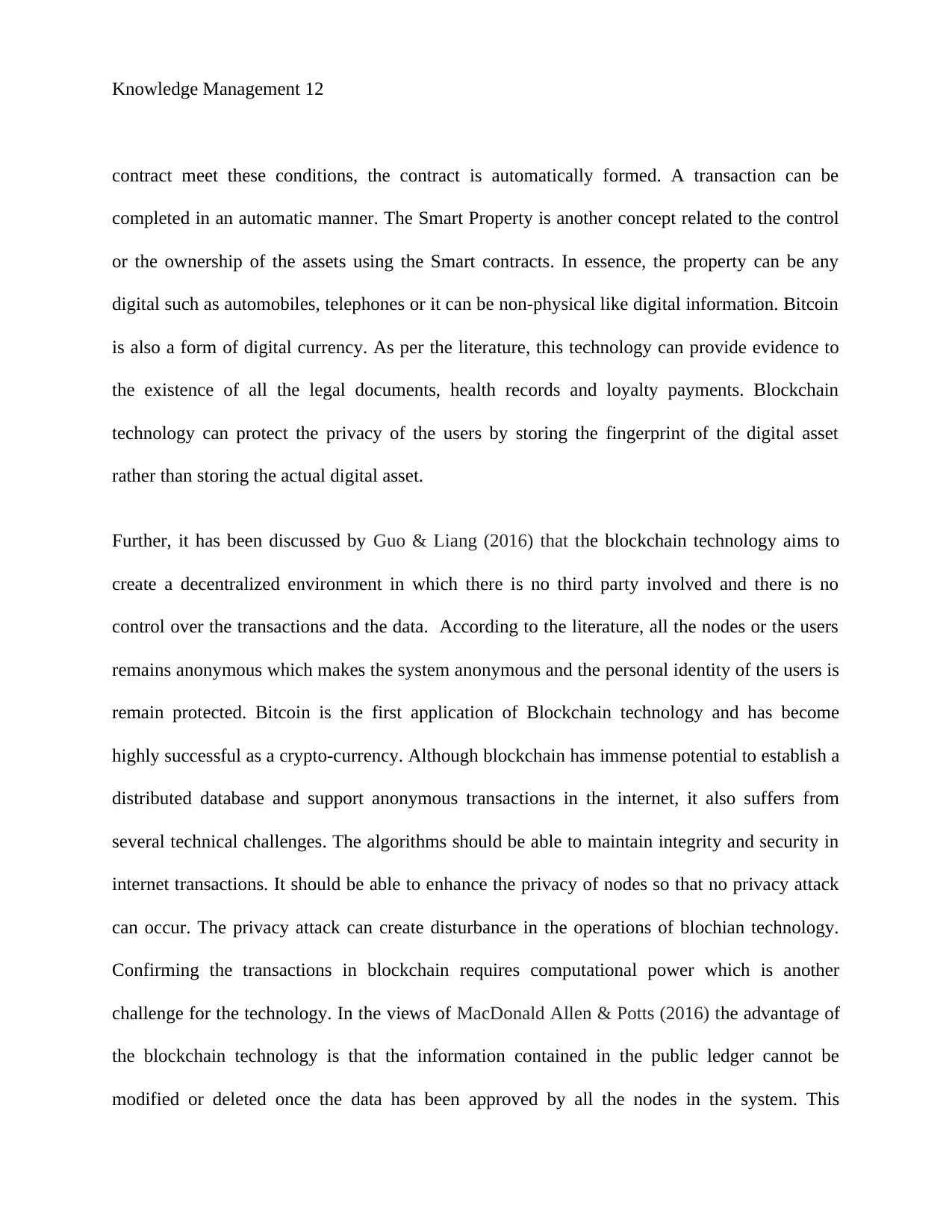
Knowledge Management 12
contract meet these conditions, the contract is automatically formed. A transaction can be
completed in an automatic manner. The Smart Property is another concept related to the control
or the ownership of the assets using the Smart contracts. In essence, the property can be any
digital such as automobiles, telephones or it can be non-physical like digital information. Bitcoin
is also a form of digital currency. As per the literature, this technology can provide evidence to
the existence of all the legal documents, health records and loyalty payments. Blockchain
technology can protect the privacy of the users by storing the fingerprint of the digital asset
rather than storing the actual digital asset.
Further, it has been discussed by Guo & Liang (2016) that the blockchain technology aims to
create a decentralized environment in which there is no third party involved and there is no
control over the transactions and the data. According to the literature, all the nodes or the users
remains anonymous which makes the system anonymous and the personal identity of the users is
remain protected. Bitcoin is the first application of Blockchain technology and has become
highly successful as a crypto-currency. Although blockchain has immense potential to establish a
distributed database and support anonymous transactions in the internet, it also suffers from
several technical challenges. The algorithms should be able to maintain integrity and security in
internet transactions. It should be able to enhance the privacy of nodes so that no privacy attack
can occur. The privacy attack can create disturbance in the operations of blochian technology.
Confirming the transactions in blockchain requires computational power which is another
challenge for the technology. In the views of MacDonald Allen & Potts (2016) the advantage of
the blockchain technology is that the information contained in the public ledger cannot be
modified or deleted once the data has been approved by all the nodes in the system. This
contract meet these conditions, the contract is automatically formed. A transaction can be
completed in an automatic manner. The Smart Property is another concept related to the control
or the ownership of the assets using the Smart contracts. In essence, the property can be any
digital such as automobiles, telephones or it can be non-physical like digital information. Bitcoin
is also a form of digital currency. As per the literature, this technology can provide evidence to
the existence of all the legal documents, health records and loyalty payments. Blockchain
technology can protect the privacy of the users by storing the fingerprint of the digital asset
rather than storing the actual digital asset.
Further, it has been discussed by Guo & Liang (2016) that the blockchain technology aims to
create a decentralized environment in which there is no third party involved and there is no
control over the transactions and the data. According to the literature, all the nodes or the users
remains anonymous which makes the system anonymous and the personal identity of the users is
remain protected. Bitcoin is the first application of Blockchain technology and has become
highly successful as a crypto-currency. Although blockchain has immense potential to establish a
distributed database and support anonymous transactions in the internet, it also suffers from
several technical challenges. The algorithms should be able to maintain integrity and security in
internet transactions. It should be able to enhance the privacy of nodes so that no privacy attack
can occur. The privacy attack can create disturbance in the operations of blochian technology.
Confirming the transactions in blockchain requires computational power which is another
challenge for the technology. In the views of MacDonald Allen & Potts (2016) the advantage of
the blockchain technology is that the information contained in the public ledger cannot be
modified or deleted once the data has been approved by all the nodes in the system. This
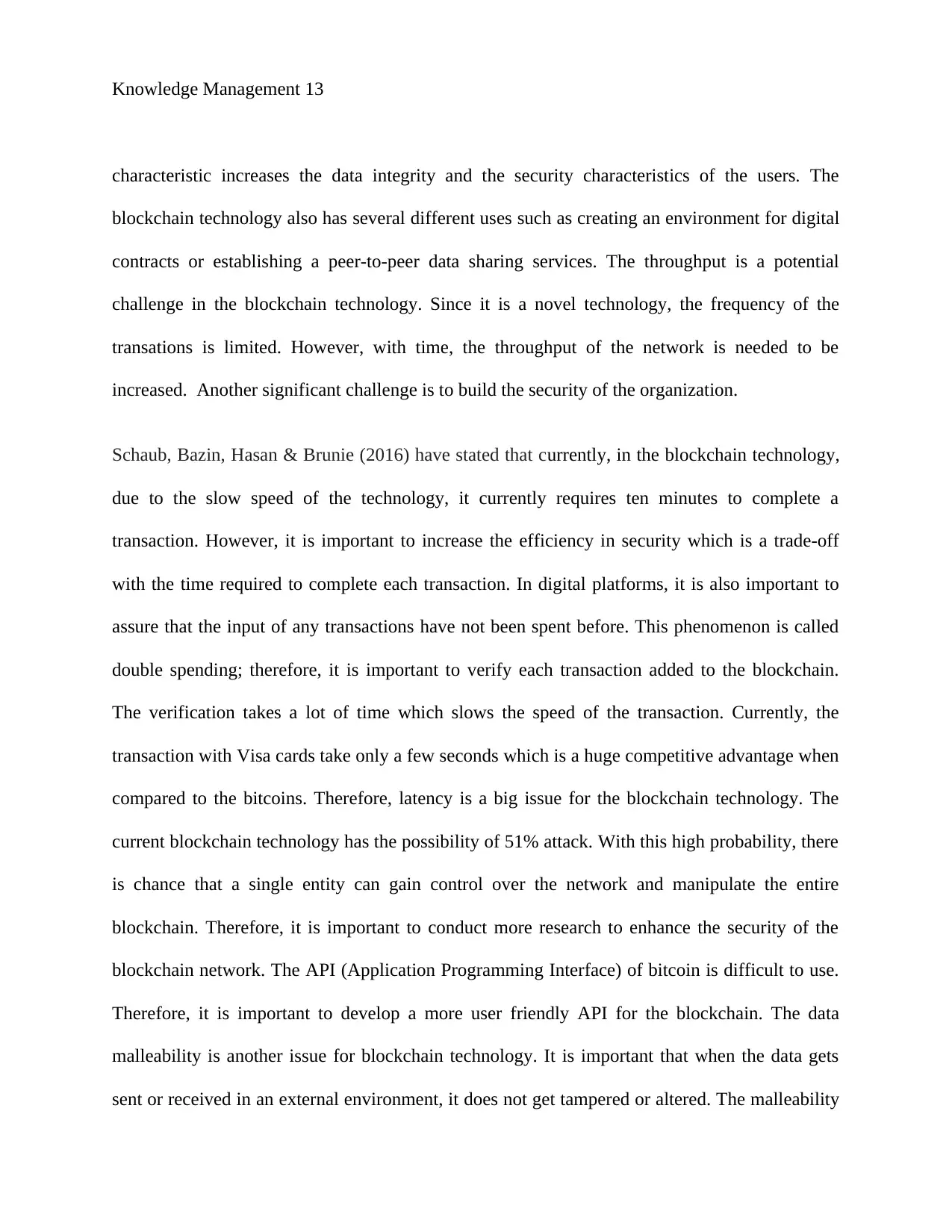
Knowledge Management 13
characteristic increases the data integrity and the security characteristics of the users. The
blockchain technology also has several different uses such as creating an environment for digital
contracts or establishing a peer-to-peer data sharing services. The throughput is a potential
challenge in the blockchain technology. Since it is a novel technology, the frequency of the
transations is limited. However, with time, the throughput of the network is needed to be
increased. Another significant challenge is to build the security of the organization.
Schaub, Bazin, Hasan & Brunie (2016) have stated that currently, in the blockchain technology,
due to the slow speed of the technology, it currently requires ten minutes to complete a
transaction. However, it is important to increase the efficiency in security which is a trade-off
with the time required to complete each transaction. In digital platforms, it is also important to
assure that the input of any transactions have not been spent before. This phenomenon is called
double spending; therefore, it is important to verify each transaction added to the blockchain.
The verification takes a lot of time which slows the speed of the transaction. Currently, the
transaction with Visa cards take only a few seconds which is a huge competitive advantage when
compared to the bitcoins. Therefore, latency is a big issue for the blockchain technology. The
current blockchain technology has the possibility of 51% attack. With this high probability, there
is chance that a single entity can gain control over the network and manipulate the entire
blockchain. Therefore, it is important to conduct more research to enhance the security of the
blockchain network. The API (Application Programming Interface) of bitcoin is difficult to use.
Therefore, it is important to develop a more user friendly API for the blockchain. The data
malleability is another issue for blockchain technology. It is important that when the data gets
sent or received in an external environment, it does not get tampered or altered. The malleability
characteristic increases the data integrity and the security characteristics of the users. The
blockchain technology also has several different uses such as creating an environment for digital
contracts or establishing a peer-to-peer data sharing services. The throughput is a potential
challenge in the blockchain technology. Since it is a novel technology, the frequency of the
transations is limited. However, with time, the throughput of the network is needed to be
increased. Another significant challenge is to build the security of the organization.
Schaub, Bazin, Hasan & Brunie (2016) have stated that currently, in the blockchain technology,
due to the slow speed of the technology, it currently requires ten minutes to complete a
transaction. However, it is important to increase the efficiency in security which is a trade-off
with the time required to complete each transaction. In digital platforms, it is also important to
assure that the input of any transactions have not been spent before. This phenomenon is called
double spending; therefore, it is important to verify each transaction added to the blockchain.
The verification takes a lot of time which slows the speed of the transaction. Currently, the
transaction with Visa cards take only a few seconds which is a huge competitive advantage when
compared to the bitcoins. Therefore, latency is a big issue for the blockchain technology. The
current blockchain technology has the possibility of 51% attack. With this high probability, there
is chance that a single entity can gain control over the network and manipulate the entire
blockchain. Therefore, it is important to conduct more research to enhance the security of the
blockchain network. The API (Application Programming Interface) of bitcoin is difficult to use.
Therefore, it is important to develop a more user friendly API for the blockchain. The data
malleability is another issue for blockchain technology. It is important that when the data gets
sent or received in an external environment, it does not get tampered or altered. The malleability
Paraphrase This Document
Need a fresh take? Get an instant paraphrase of this document with our AI Paraphraser
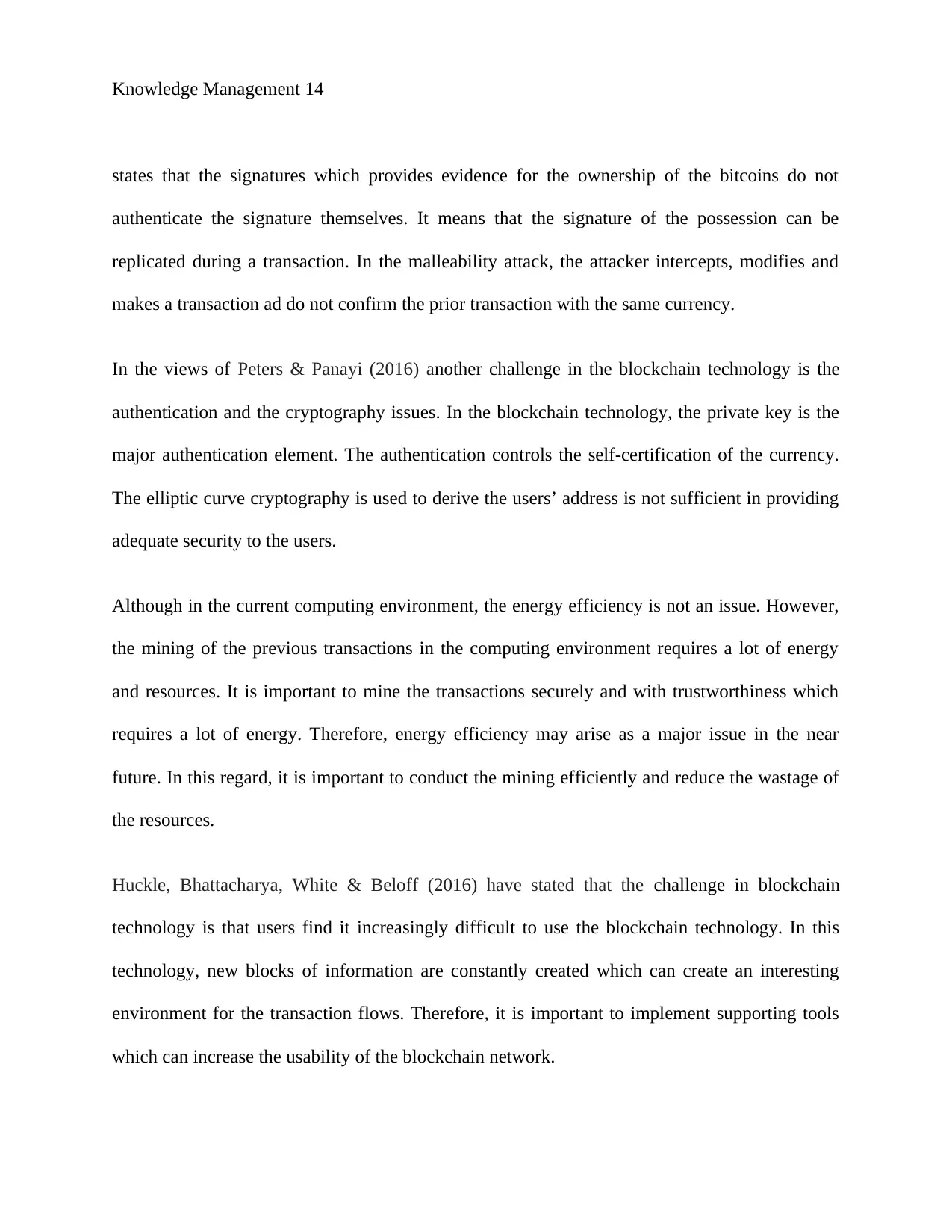
Knowledge Management 14
states that the signatures which provides evidence for the ownership of the bitcoins do not
authenticate the signature themselves. It means that the signature of the possession can be
replicated during a transaction. In the malleability attack, the attacker intercepts, modifies and
makes a transaction ad do not confirm the prior transaction with the same currency.
In the views of Peters & Panayi (2016) another challenge in the blockchain technology is the
authentication and the cryptography issues. In the blockchain technology, the private key is the
major authentication element. The authentication controls the self-certification of the currency.
The elliptic curve cryptography is used to derive the users’ address is not sufficient in providing
adequate security to the users.
Although in the current computing environment, the energy efficiency is not an issue. However,
the mining of the previous transactions in the computing environment requires a lot of energy
and resources. It is important to mine the transactions securely and with trustworthiness which
requires a lot of energy. Therefore, energy efficiency may arise as a major issue in the near
future. In this regard, it is important to conduct the mining efficiently and reduce the wastage of
the resources.
Huckle, Bhattacharya, White & Beloff (2016) have stated that the challenge in blockchain
technology is that users find it increasingly difficult to use the blockchain technology. In this
technology, new blocks of information are constantly created which can create an interesting
environment for the transaction flows. Therefore, it is important to implement supporting tools
which can increase the usability of the blockchain network.
states that the signatures which provides evidence for the ownership of the bitcoins do not
authenticate the signature themselves. It means that the signature of the possession can be
replicated during a transaction. In the malleability attack, the attacker intercepts, modifies and
makes a transaction ad do not confirm the prior transaction with the same currency.
In the views of Peters & Panayi (2016) another challenge in the blockchain technology is the
authentication and the cryptography issues. In the blockchain technology, the private key is the
major authentication element. The authentication controls the self-certification of the currency.
The elliptic curve cryptography is used to derive the users’ address is not sufficient in providing
adequate security to the users.
Although in the current computing environment, the energy efficiency is not an issue. However,
the mining of the previous transactions in the computing environment requires a lot of energy
and resources. It is important to mine the transactions securely and with trustworthiness which
requires a lot of energy. Therefore, energy efficiency may arise as a major issue in the near
future. In this regard, it is important to conduct the mining efficiently and reduce the wastage of
the resources.
Huckle, Bhattacharya, White & Beloff (2016) have stated that the challenge in blockchain
technology is that users find it increasingly difficult to use the blockchain technology. In this
technology, new blocks of information are constantly created which can create an interesting
environment for the transaction flows. Therefore, it is important to implement supporting tools
which can increase the usability of the blockchain network.
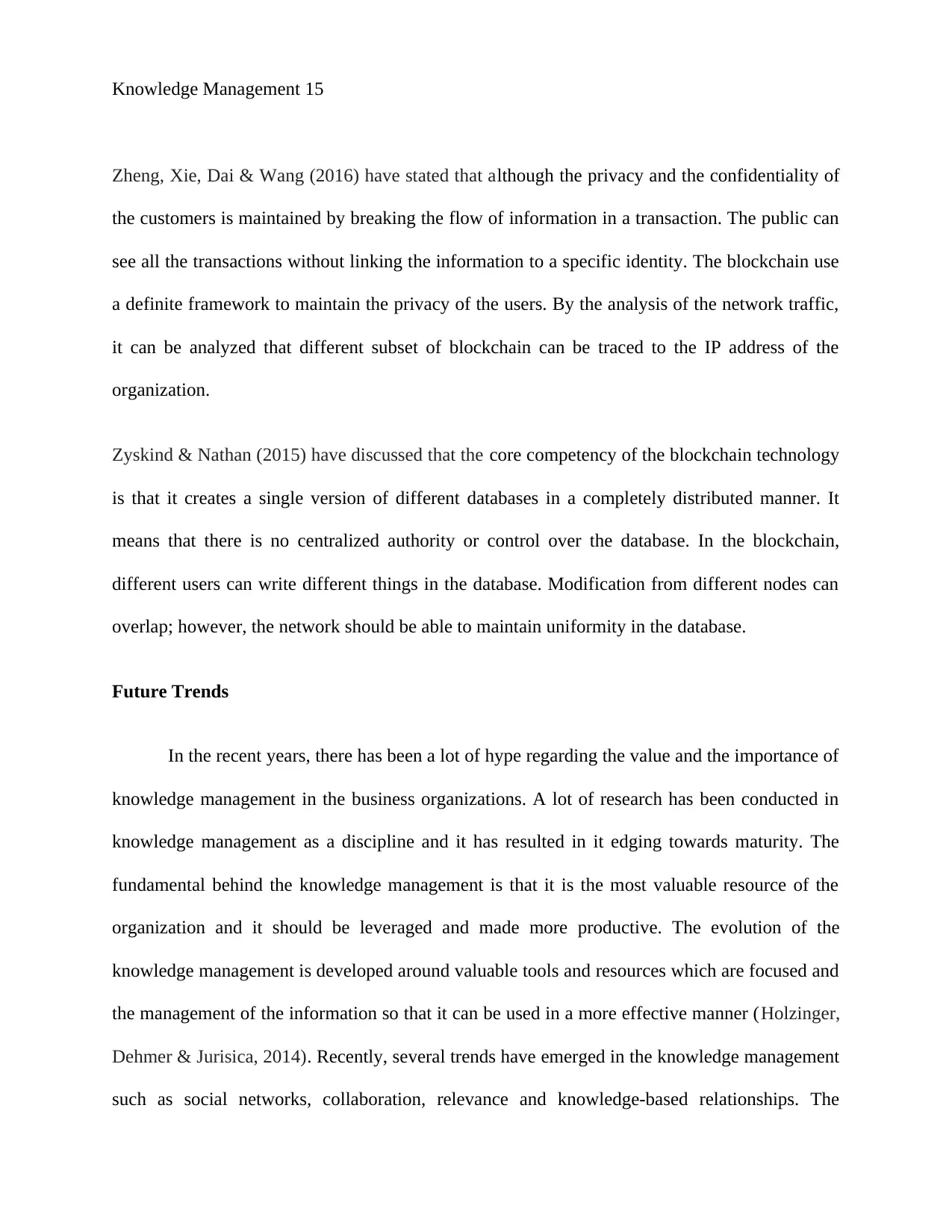
Knowledge Management 15
Zheng, Xie, Dai & Wang (2016) have stated that although the privacy and the confidentiality of
the customers is maintained by breaking the flow of information in a transaction. The public can
see all the transactions without linking the information to a specific identity. The blockchain use
a definite framework to maintain the privacy of the users. By the analysis of the network traffic,
it can be analyzed that different subset of blockchain can be traced to the IP address of the
organization.
Zyskind & Nathan (2015) have discussed that the core competency of the blockchain technology
is that it creates a single version of different databases in a completely distributed manner. It
means that there is no centralized authority or control over the database. In the blockchain,
different users can write different things in the database. Modification from different nodes can
overlap; however, the network should be able to maintain uniformity in the database.
Future Trends
In the recent years, there has been a lot of hype regarding the value and the importance of
knowledge management in the business organizations. A lot of research has been conducted in
knowledge management as a discipline and it has resulted in it edging towards maturity. The
fundamental behind the knowledge management is that it is the most valuable resource of the
organization and it should be leveraged and made more productive. The evolution of the
knowledge management is developed around valuable tools and resources which are focused and
the management of the information so that it can be used in a more effective manner (Holzinger,
Dehmer & Jurisica, 2014). Recently, several trends have emerged in the knowledge management
such as social networks, collaboration, relevance and knowledge-based relationships. The
Zheng, Xie, Dai & Wang (2016) have stated that although the privacy and the confidentiality of
the customers is maintained by breaking the flow of information in a transaction. The public can
see all the transactions without linking the information to a specific identity. The blockchain use
a definite framework to maintain the privacy of the users. By the analysis of the network traffic,
it can be analyzed that different subset of blockchain can be traced to the IP address of the
organization.
Zyskind & Nathan (2015) have discussed that the core competency of the blockchain technology
is that it creates a single version of different databases in a completely distributed manner. It
means that there is no centralized authority or control over the database. In the blockchain,
different users can write different things in the database. Modification from different nodes can
overlap; however, the network should be able to maintain uniformity in the database.
Future Trends
In the recent years, there has been a lot of hype regarding the value and the importance of
knowledge management in the business organizations. A lot of research has been conducted in
knowledge management as a discipline and it has resulted in it edging towards maturity. The
fundamental behind the knowledge management is that it is the most valuable resource of the
organization and it should be leveraged and made more productive. The evolution of the
knowledge management is developed around valuable tools and resources which are focused and
the management of the information so that it can be used in a more effective manner (Holzinger,
Dehmer & Jurisica, 2014). Recently, several trends have emerged in the knowledge management
such as social networks, collaboration, relevance and knowledge-based relationships. The
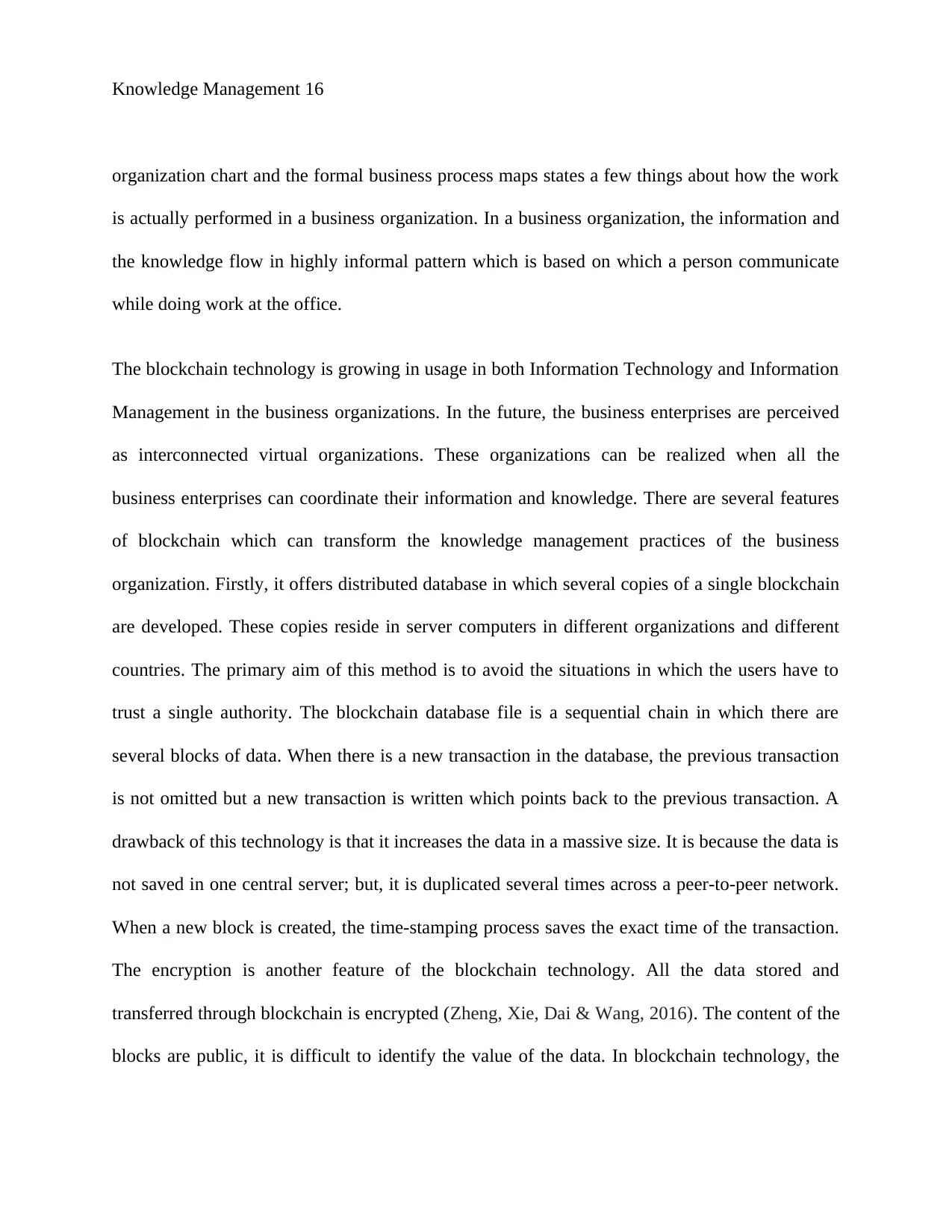
Knowledge Management 16
organization chart and the formal business process maps states a few things about how the work
is actually performed in a business organization. In a business organization, the information and
the knowledge flow in highly informal pattern which is based on which a person communicate
while doing work at the office.
The blockchain technology is growing in usage in both Information Technology and Information
Management in the business organizations. In the future, the business enterprises are perceived
as interconnected virtual organizations. These organizations can be realized when all the
business enterprises can coordinate their information and knowledge. There are several features
of blockchain which can transform the knowledge management practices of the business
organization. Firstly, it offers distributed database in which several copies of a single blockchain
are developed. These copies reside in server computers in different organizations and different
countries. The primary aim of this method is to avoid the situations in which the users have to
trust a single authority. The blockchain database file is a sequential chain in which there are
several blocks of data. When there is a new transaction in the database, the previous transaction
is not omitted but a new transaction is written which points back to the previous transaction. A
drawback of this technology is that it increases the data in a massive size. It is because the data is
not saved in one central server; but, it is duplicated several times across a peer-to-peer network.
When a new block is created, the time-stamping process saves the exact time of the transaction.
The encryption is another feature of the blockchain technology. All the data stored and
transferred through blockchain is encrypted (Zheng, Xie, Dai & Wang, 2016). The content of the
blocks are public, it is difficult to identify the value of the data. In blockchain technology, the
organization chart and the formal business process maps states a few things about how the work
is actually performed in a business organization. In a business organization, the information and
the knowledge flow in highly informal pattern which is based on which a person communicate
while doing work at the office.
The blockchain technology is growing in usage in both Information Technology and Information
Management in the business organizations. In the future, the business enterprises are perceived
as interconnected virtual organizations. These organizations can be realized when all the
business enterprises can coordinate their information and knowledge. There are several features
of blockchain which can transform the knowledge management practices of the business
organization. Firstly, it offers distributed database in which several copies of a single blockchain
are developed. These copies reside in server computers in different organizations and different
countries. The primary aim of this method is to avoid the situations in which the users have to
trust a single authority. The blockchain database file is a sequential chain in which there are
several blocks of data. When there is a new transaction in the database, the previous transaction
is not omitted but a new transaction is written which points back to the previous transaction. A
drawback of this technology is that it increases the data in a massive size. It is because the data is
not saved in one central server; but, it is duplicated several times across a peer-to-peer network.
When a new block is created, the time-stamping process saves the exact time of the transaction.
The encryption is another feature of the blockchain technology. All the data stored and
transferred through blockchain is encrypted (Zheng, Xie, Dai & Wang, 2016). The content of the
blocks are public, it is difficult to identify the value of the data. In blockchain technology, the
Secure Best Marks with AI Grader
Need help grading? Try our AI Grader for instant feedback on your assignments.

Knowledge Management 17
management of the database is conducted by distributed software so there is no single system
which controls the database.
In the future, blockchain can be a part of the knowledge management as it can be used for the
knowledge procurement. It can be used in Islamic finance to corruption-free foreign aid
payment. The key advantage of blockchain is its transparency which can be used to create
financial spreadsheets for all the financial transactions of the business organizations. In the
traditional times, all the relevant information related to the business organizations was stored
within the organization itself. However, challenges arises when the data is exchanged between
different entities and the business organization (Sun, Yan & Zhang, 2016). The communication
channels are just the agent of transmitting the information.
It is also essential in improving the medical quality and improving the privacy of the patients.
The decentralized, encrypted public ledger can provide a wealth of application in healthcare. It
can streamline the resolution of insurance claims, manage internet of things, medical devices and
increase the privacy settings of the medical data. It can protect the privacy and the confidentiality
of the patients. A research has been going on in which the patients will be given the ability to set
the privacy setting of their own data. The technology has not been yet identified; however, a
technology can be developed in which the records component will be broken down to smaller
pieces and access will be given step by step. No additional information will be given to any
potential recipient of the information (Zheng, Xie, Dai, Chen & Wang, 2017).
The blockchain technology can also be used for the resolution of the insurance claims in an
organization. The records of the users can be posted to a private blockchain which can allow
management of the database is conducted by distributed software so there is no single system
which controls the database.
In the future, blockchain can be a part of the knowledge management as it can be used for the
knowledge procurement. It can be used in Islamic finance to corruption-free foreign aid
payment. The key advantage of blockchain is its transparency which can be used to create
financial spreadsheets for all the financial transactions of the business organizations. In the
traditional times, all the relevant information related to the business organizations was stored
within the organization itself. However, challenges arises when the data is exchanged between
different entities and the business organization (Sun, Yan & Zhang, 2016). The communication
channels are just the agent of transmitting the information.
It is also essential in improving the medical quality and improving the privacy of the patients.
The decentralized, encrypted public ledger can provide a wealth of application in healthcare. It
can streamline the resolution of insurance claims, manage internet of things, medical devices and
increase the privacy settings of the medical data. It can protect the privacy and the confidentiality
of the patients. A research has been going on in which the patients will be given the ability to set
the privacy setting of their own data. The technology has not been yet identified; however, a
technology can be developed in which the records component will be broken down to smaller
pieces and access will be given step by step. No additional information will be given to any
potential recipient of the information (Zheng, Xie, Dai, Chen & Wang, 2017).
The blockchain technology can also be used for the resolution of the insurance claims in an
organization. The records of the users can be posted to a private blockchain which can allow
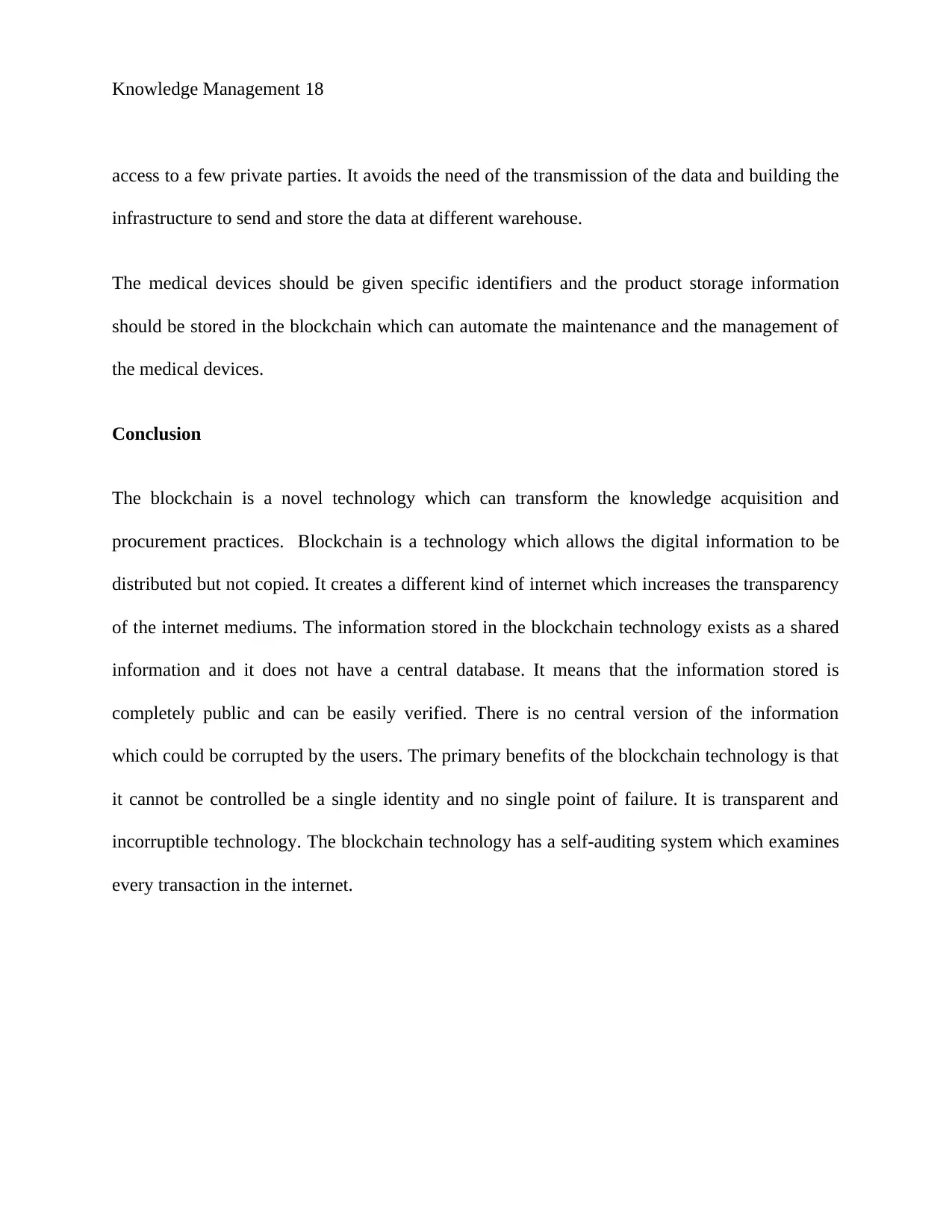
Knowledge Management 18
access to a few private parties. It avoids the need of the transmission of the data and building the
infrastructure to send and store the data at different warehouse.
The medical devices should be given specific identifiers and the product storage information
should be stored in the blockchain which can automate the maintenance and the management of
the medical devices.
Conclusion
The blockchain is a novel technology which can transform the knowledge acquisition and
procurement practices. Blockchain is a technology which allows the digital information to be
distributed but not copied. It creates a different kind of internet which increases the transparency
of the internet mediums. The information stored in the blockchain technology exists as a shared
information and it does not have a central database. It means that the information stored is
completely public and can be easily verified. There is no central version of the information
which could be corrupted by the users. The primary benefits of the blockchain technology is that
it cannot be controlled be a single identity and no single point of failure. It is transparent and
incorruptible technology. The blockchain technology has a self-auditing system which examines
every transaction in the internet.
access to a few private parties. It avoids the need of the transmission of the data and building the
infrastructure to send and store the data at different warehouse.
The medical devices should be given specific identifiers and the product storage information
should be stored in the blockchain which can automate the maintenance and the management of
the medical devices.
Conclusion
The blockchain is a novel technology which can transform the knowledge acquisition and
procurement practices. Blockchain is a technology which allows the digital information to be
distributed but not copied. It creates a different kind of internet which increases the transparency
of the internet mediums. The information stored in the blockchain technology exists as a shared
information and it does not have a central database. It means that the information stored is
completely public and can be easily verified. There is no central version of the information
which could be corrupted by the users. The primary benefits of the blockchain technology is that
it cannot be controlled be a single identity and no single point of failure. It is transparent and
incorruptible technology. The blockchain technology has a self-auditing system which examines
every transaction in the internet.
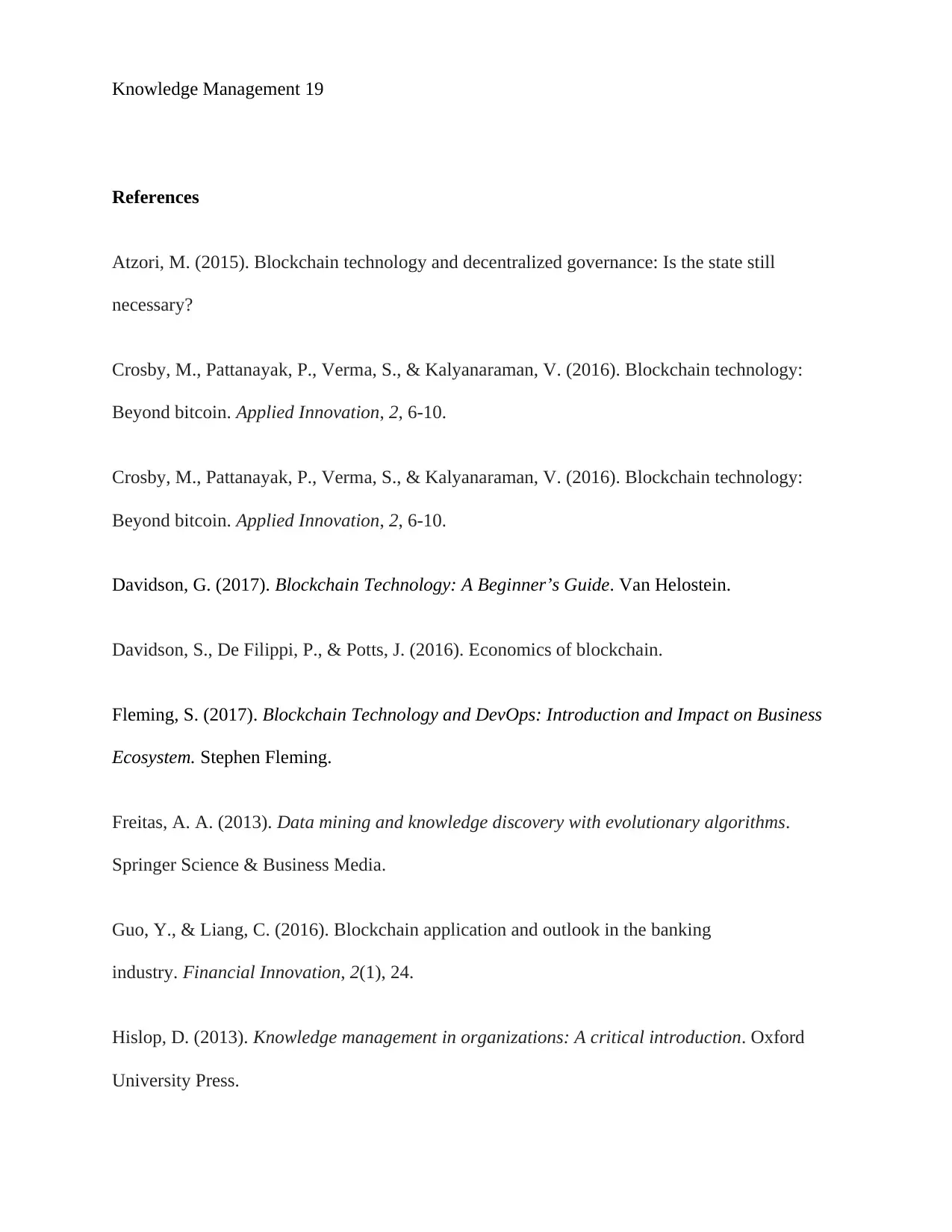
Knowledge Management 19
References
Atzori, M. (2015). Blockchain technology and decentralized governance: Is the state still
necessary?
Crosby, M., Pattanayak, P., Verma, S., & Kalyanaraman, V. (2016). Blockchain technology:
Beyond bitcoin. Applied Innovation, 2, 6-10.
Crosby, M., Pattanayak, P., Verma, S., & Kalyanaraman, V. (2016). Blockchain technology:
Beyond bitcoin. Applied Innovation, 2, 6-10.
Davidson, G. (2017). Blockchain Technology: A Beginner’s Guide. Van Helostein.
Davidson, S., De Filippi, P., & Potts, J. (2016). Economics of blockchain.
Fleming, S. (2017). Blockchain Technology and DevOps: Introduction and Impact on Business
Ecosystem. Stephen Fleming.
Freitas, A. A. (2013). Data mining and knowledge discovery with evolutionary algorithms.
Springer Science & Business Media.
Guo, Y., & Liang, C. (2016). Blockchain application and outlook in the banking
industry. Financial Innovation, 2(1), 24.
Hislop, D. (2013). Knowledge management in organizations: A critical introduction. Oxford
University Press.
References
Atzori, M. (2015). Blockchain technology and decentralized governance: Is the state still
necessary?
Crosby, M., Pattanayak, P., Verma, S., & Kalyanaraman, V. (2016). Blockchain technology:
Beyond bitcoin. Applied Innovation, 2, 6-10.
Crosby, M., Pattanayak, P., Verma, S., & Kalyanaraman, V. (2016). Blockchain technology:
Beyond bitcoin. Applied Innovation, 2, 6-10.
Davidson, G. (2017). Blockchain Technology: A Beginner’s Guide. Van Helostein.
Davidson, S., De Filippi, P., & Potts, J. (2016). Economics of blockchain.
Fleming, S. (2017). Blockchain Technology and DevOps: Introduction and Impact on Business
Ecosystem. Stephen Fleming.
Freitas, A. A. (2013). Data mining and knowledge discovery with evolutionary algorithms.
Springer Science & Business Media.
Guo, Y., & Liang, C. (2016). Blockchain application and outlook in the banking
industry. Financial Innovation, 2(1), 24.
Hislop, D. (2013). Knowledge management in organizations: A critical introduction. Oxford
University Press.
Paraphrase This Document
Need a fresh take? Get an instant paraphrase of this document with our AI Paraphraser
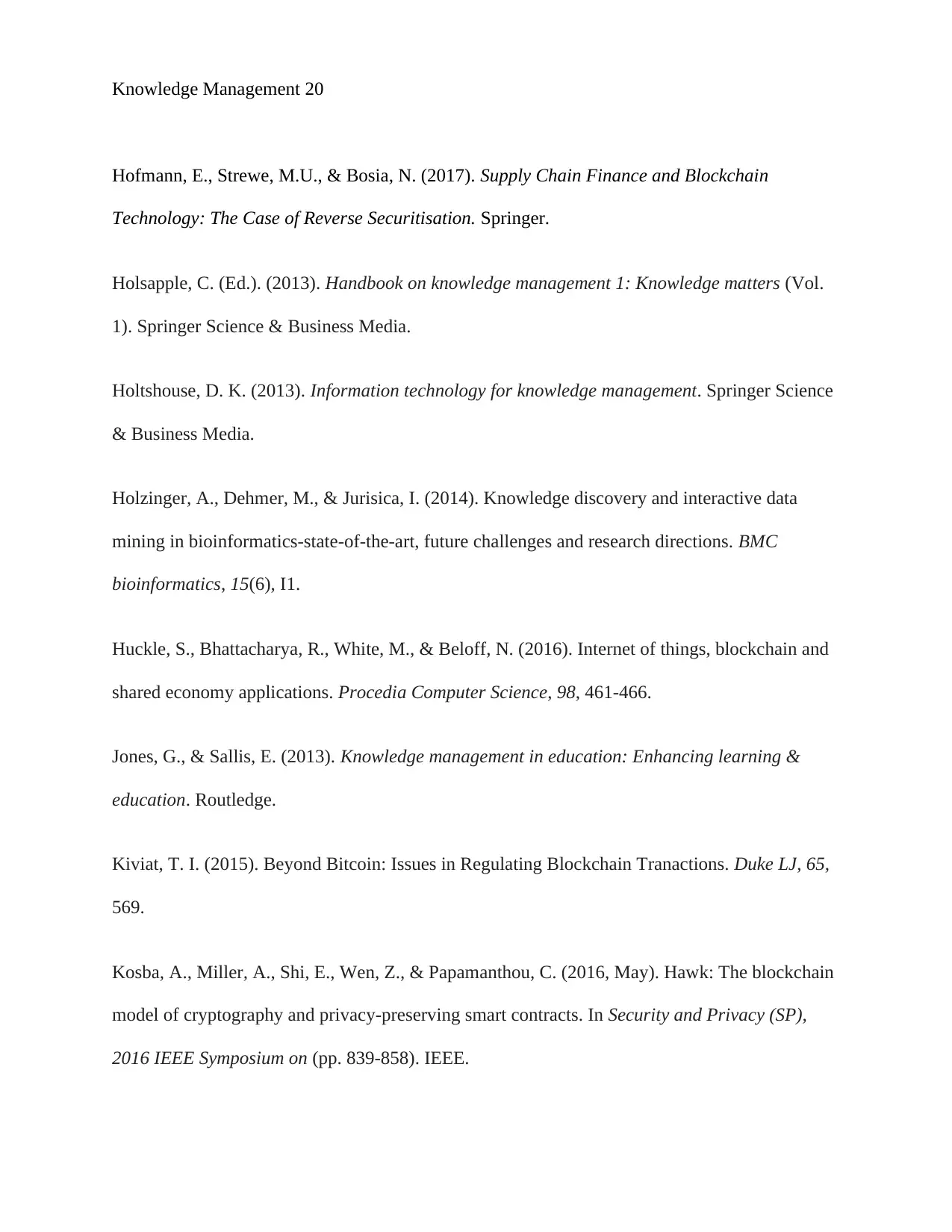
Knowledge Management 20
Hofmann, E., Strewe, M.U., & Bosia, N. (2017). Supply Chain Finance and Blockchain
Technology: The Case of Reverse Securitisation. Springer.
Holsapple, C. (Ed.). (2013). Handbook on knowledge management 1: Knowledge matters (Vol.
1). Springer Science & Business Media.
Holtshouse, D. K. (2013). Information technology for knowledge management. Springer Science
& Business Media.
Holzinger, A., Dehmer, M., & Jurisica, I. (2014). Knowledge discovery and interactive data
mining in bioinformatics-state-of-the-art, future challenges and research directions. BMC
bioinformatics, 15(6), I1.
Huckle, S., Bhattacharya, R., White, M., & Beloff, N. (2016). Internet of things, blockchain and
shared economy applications. Procedia Computer Science, 98, 461-466.
Jones, G., & Sallis, E. (2013). Knowledge management in education: Enhancing learning &
education. Routledge.
Kiviat, T. I. (2015). Beyond Bitcoin: Issues in Regulating Blockchain Tranactions. Duke LJ, 65,
569.
Kosba, A., Miller, A., Shi, E., Wen, Z., & Papamanthou, C. (2016, May). Hawk: The blockchain
model of cryptography and privacy-preserving smart contracts. In Security and Privacy (SP),
2016 IEEE Symposium on (pp. 839-858). IEEE.
Hofmann, E., Strewe, M.U., & Bosia, N. (2017). Supply Chain Finance and Blockchain
Technology: The Case of Reverse Securitisation. Springer.
Holsapple, C. (Ed.). (2013). Handbook on knowledge management 1: Knowledge matters (Vol.
1). Springer Science & Business Media.
Holtshouse, D. K. (2013). Information technology for knowledge management. Springer Science
& Business Media.
Holzinger, A., Dehmer, M., & Jurisica, I. (2014). Knowledge discovery and interactive data
mining in bioinformatics-state-of-the-art, future challenges and research directions. BMC
bioinformatics, 15(6), I1.
Huckle, S., Bhattacharya, R., White, M., & Beloff, N. (2016). Internet of things, blockchain and
shared economy applications. Procedia Computer Science, 98, 461-466.
Jones, G., & Sallis, E. (2013). Knowledge management in education: Enhancing learning &
education. Routledge.
Kiviat, T. I. (2015). Beyond Bitcoin: Issues in Regulating Blockchain Tranactions. Duke LJ, 65,
569.
Kosba, A., Miller, A., Shi, E., Wen, Z., & Papamanthou, C. (2016, May). Hawk: The blockchain
model of cryptography and privacy-preserving smart contracts. In Security and Privacy (SP),
2016 IEEE Symposium on (pp. 839-858). IEEE.
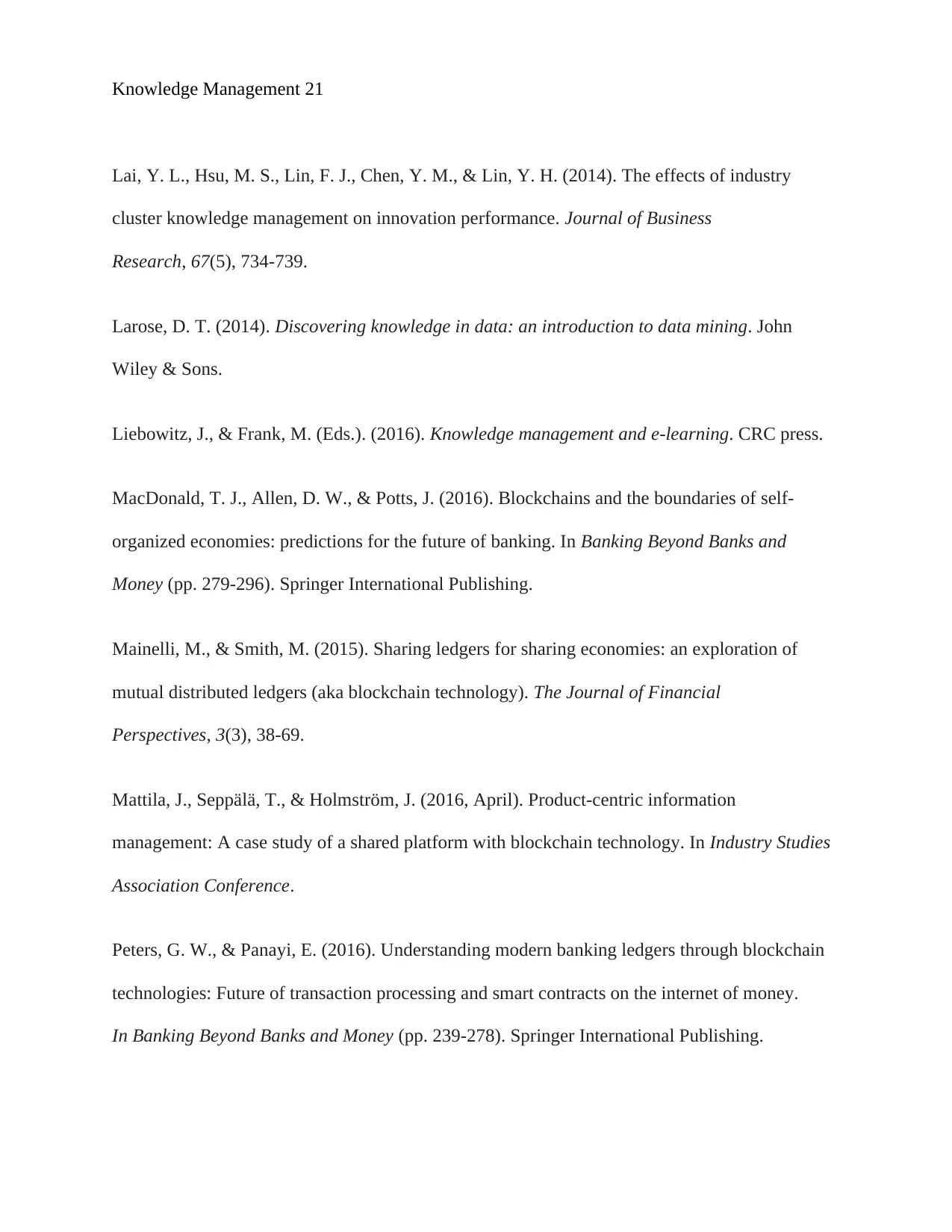
Knowledge Management 21
Lai, Y. L., Hsu, M. S., Lin, F. J., Chen, Y. M., & Lin, Y. H. (2014). The effects of industry
cluster knowledge management on innovation performance. Journal of Business
Research, 67(5), 734-739.
Larose, D. T. (2014). Discovering knowledge in data: an introduction to data mining. John
Wiley & Sons.
Liebowitz, J., & Frank, M. (Eds.). (2016). Knowledge management and e-learning. CRC press.
MacDonald, T. J., Allen, D. W., & Potts, J. (2016). Blockchains and the boundaries of self-
organized economies: predictions for the future of banking. In Banking Beyond Banks and
Money (pp. 279-296). Springer International Publishing.
Mainelli, M., & Smith, M. (2015). Sharing ledgers for sharing economies: an exploration of
mutual distributed ledgers (aka blockchain technology). The Journal of Financial
Perspectives, 3(3), 38-69.
Mattila, J., Seppälä, T., & Holmström, J. (2016, April). Product-centric information
management: A case study of a shared platform with blockchain technology. In Industry Studies
Association Conference.
Peters, G. W., & Panayi, E. (2016). Understanding modern banking ledgers through blockchain
technologies: Future of transaction processing and smart contracts on the internet of money.
In Banking Beyond Banks and Money (pp. 239-278). Springer International Publishing.
Lai, Y. L., Hsu, M. S., Lin, F. J., Chen, Y. M., & Lin, Y. H. (2014). The effects of industry
cluster knowledge management on innovation performance. Journal of Business
Research, 67(5), 734-739.
Larose, D. T. (2014). Discovering knowledge in data: an introduction to data mining. John
Wiley & Sons.
Liebowitz, J., & Frank, M. (Eds.). (2016). Knowledge management and e-learning. CRC press.
MacDonald, T. J., Allen, D. W., & Potts, J. (2016). Blockchains and the boundaries of self-
organized economies: predictions for the future of banking. In Banking Beyond Banks and
Money (pp. 279-296). Springer International Publishing.
Mainelli, M., & Smith, M. (2015). Sharing ledgers for sharing economies: an exploration of
mutual distributed ledgers (aka blockchain technology). The Journal of Financial
Perspectives, 3(3), 38-69.
Mattila, J., Seppälä, T., & Holmström, J. (2016, April). Product-centric information
management: A case study of a shared platform with blockchain technology. In Industry Studies
Association Conference.
Peters, G. W., & Panayi, E. (2016). Understanding modern banking ledgers through blockchain
technologies: Future of transaction processing and smart contracts on the internet of money.
In Banking Beyond Banks and Money (pp. 239-278). Springer International Publishing.
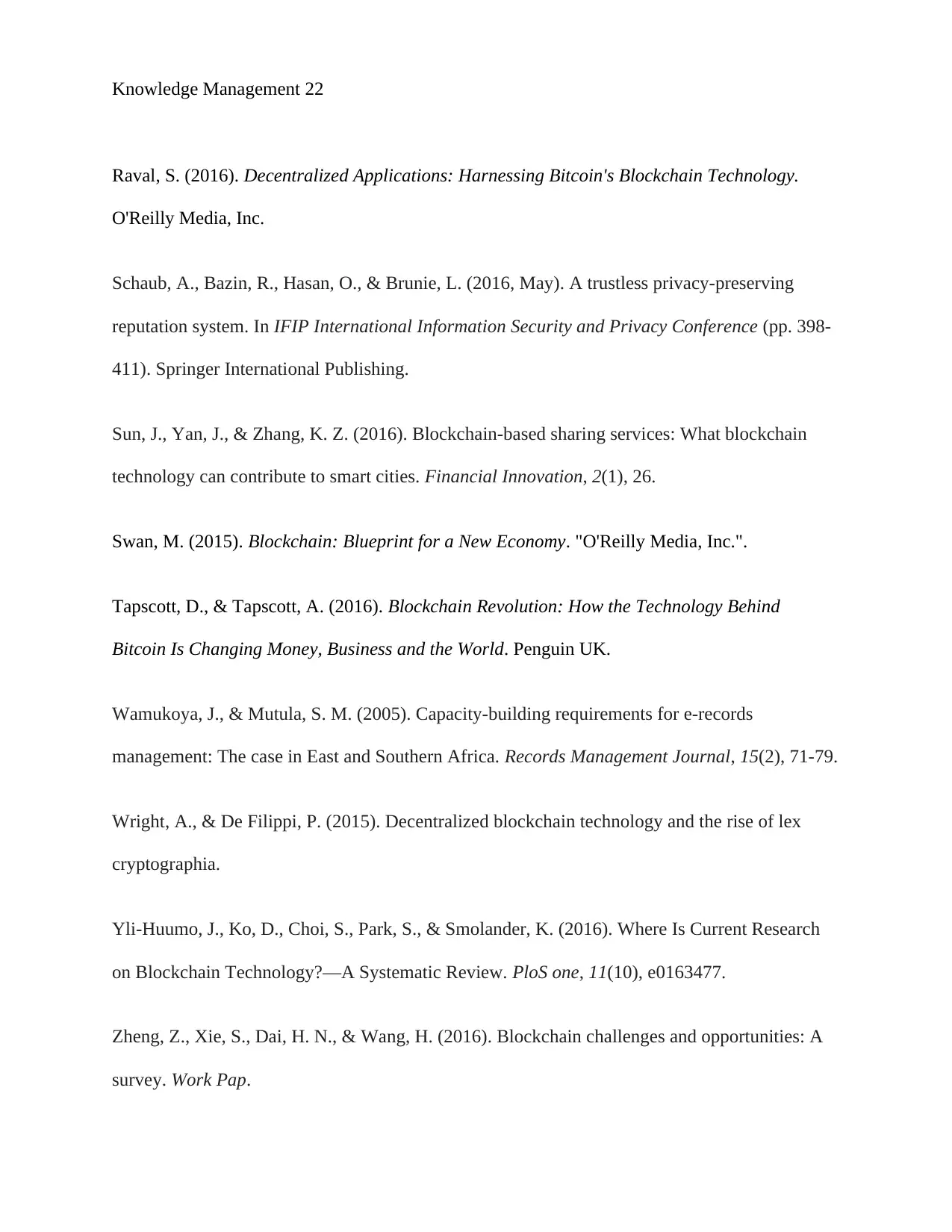
Knowledge Management 22
Raval, S. (2016). Decentralized Applications: Harnessing Bitcoin's Blockchain Technology.
O'Reilly Media, Inc.
Schaub, A., Bazin, R., Hasan, O., & Brunie, L. (2016, May). A trustless privacy-preserving
reputation system. In IFIP International Information Security and Privacy Conference (pp. 398-
411). Springer International Publishing.
Sun, J., Yan, J., & Zhang, K. Z. (2016). Blockchain-based sharing services: What blockchain
technology can contribute to smart cities. Financial Innovation, 2(1), 26.
Swan, M. (2015). Blockchain: Blueprint for a New Economy. "O'Reilly Media, Inc.".
Tapscott, D., & Tapscott, A. (2016). Blockchain Revolution: How the Technology Behind
Bitcoin Is Changing Money, Business and the World. Penguin UK.
Wamukoya, J., & Mutula, S. M. (2005). Capacity-building requirements for e-records
management: The case in East and Southern Africa. Records Management Journal, 15(2), 71-79.
Wright, A., & De Filippi, P. (2015). Decentralized blockchain technology and the rise of lex
cryptographia.
Yli-Huumo, J., Ko, D., Choi, S., Park, S., & Smolander, K. (2016). Where Is Current Research
on Blockchain Technology?—A Systematic Review. PloS one, 11(10), e0163477.
Zheng, Z., Xie, S., Dai, H. N., & Wang, H. (2016). Blockchain challenges and opportunities: A
survey. Work Pap.
Raval, S. (2016). Decentralized Applications: Harnessing Bitcoin's Blockchain Technology.
O'Reilly Media, Inc.
Schaub, A., Bazin, R., Hasan, O., & Brunie, L. (2016, May). A trustless privacy-preserving
reputation system. In IFIP International Information Security and Privacy Conference (pp. 398-
411). Springer International Publishing.
Sun, J., Yan, J., & Zhang, K. Z. (2016). Blockchain-based sharing services: What blockchain
technology can contribute to smart cities. Financial Innovation, 2(1), 26.
Swan, M. (2015). Blockchain: Blueprint for a New Economy. "O'Reilly Media, Inc.".
Tapscott, D., & Tapscott, A. (2016). Blockchain Revolution: How the Technology Behind
Bitcoin Is Changing Money, Business and the World. Penguin UK.
Wamukoya, J., & Mutula, S. M. (2005). Capacity-building requirements for e-records
management: The case in East and Southern Africa. Records Management Journal, 15(2), 71-79.
Wright, A., & De Filippi, P. (2015). Decentralized blockchain technology and the rise of lex
cryptographia.
Yli-Huumo, J., Ko, D., Choi, S., Park, S., & Smolander, K. (2016). Where Is Current Research
on Blockchain Technology?—A Systematic Review. PloS one, 11(10), e0163477.
Zheng, Z., Xie, S., Dai, H. N., & Wang, H. (2016). Blockchain challenges and opportunities: A
survey. Work Pap.
Secure Best Marks with AI Grader
Need help grading? Try our AI Grader for instant feedback on your assignments.
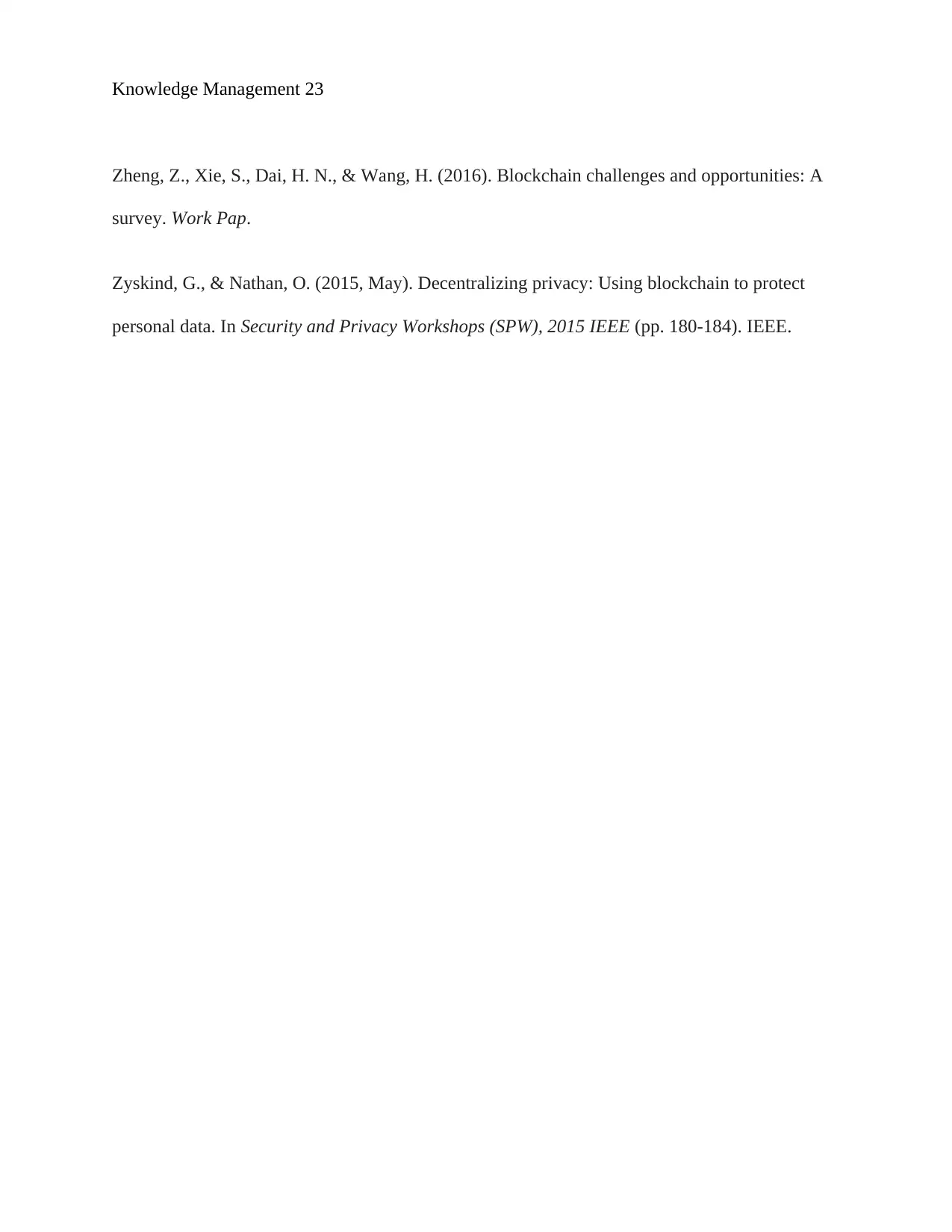
Knowledge Management 23
Zheng, Z., Xie, S., Dai, H. N., & Wang, H. (2016). Blockchain challenges and opportunities: A
survey. Work Pap.
Zyskind, G., & Nathan, O. (2015, May). Decentralizing privacy: Using blockchain to protect
personal data. In Security and Privacy Workshops (SPW), 2015 IEEE (pp. 180-184). IEEE.
Zheng, Z., Xie, S., Dai, H. N., & Wang, H. (2016). Blockchain challenges and opportunities: A
survey. Work Pap.
Zyskind, G., & Nathan, O. (2015, May). Decentralizing privacy: Using blockchain to protect
personal data. In Security and Privacy Workshops (SPW), 2015 IEEE (pp. 180-184). IEEE.
1 out of 23
Related Documents
Your All-in-One AI-Powered Toolkit for Academic Success.
+13062052269
info@desklib.com
Available 24*7 on WhatsApp / Email
![[object Object]](/_next/static/media/star-bottom.7253800d.svg)
Unlock your academic potential
© 2024 | Zucol Services PVT LTD | All rights reserved.

![Knowledge Management Cycle and Communities Report, [University Name]](/_next/image/?url=https%3A%2F%2Fdesklib.com%2Fmedia%2Fimages%2Flo%2Ffc001bdd0bc44f3791c007bc42b398cf.jpg&w=256&q=75)



